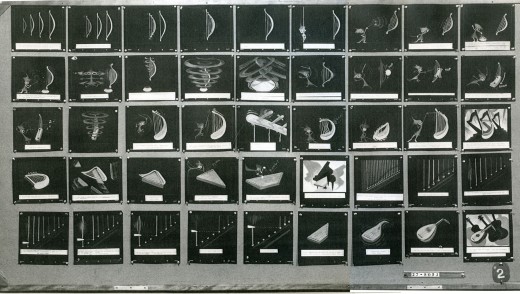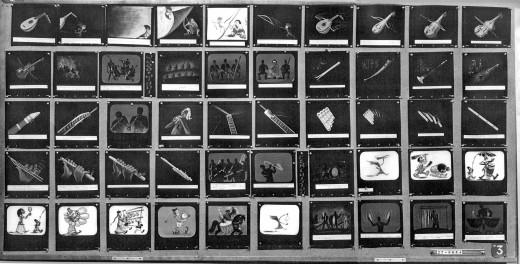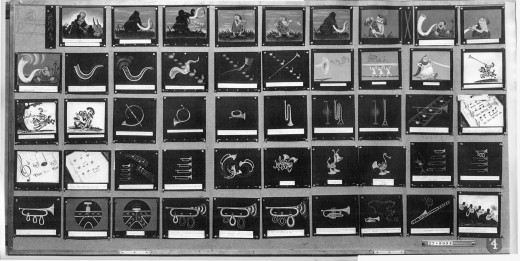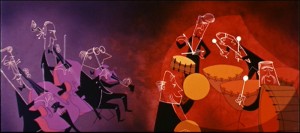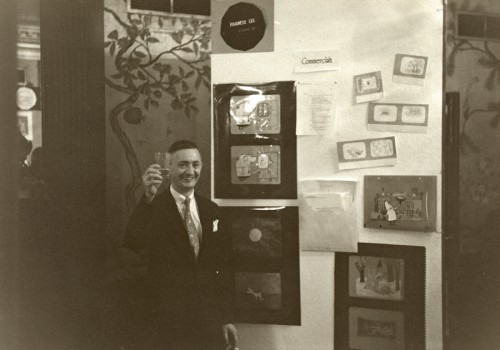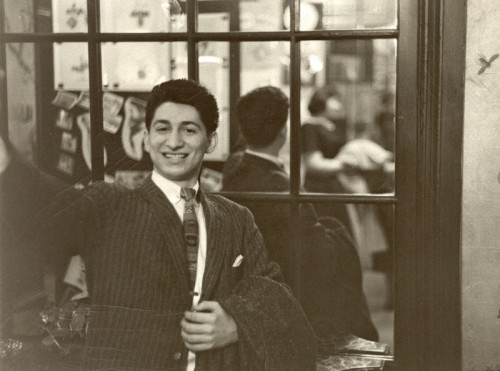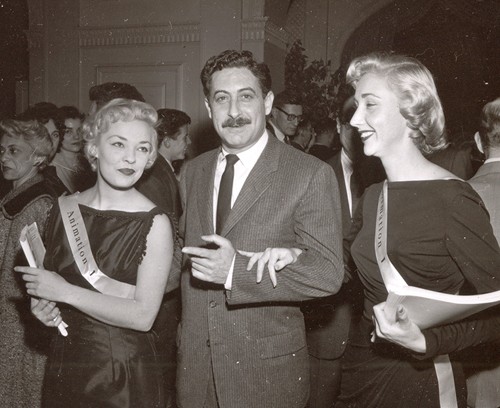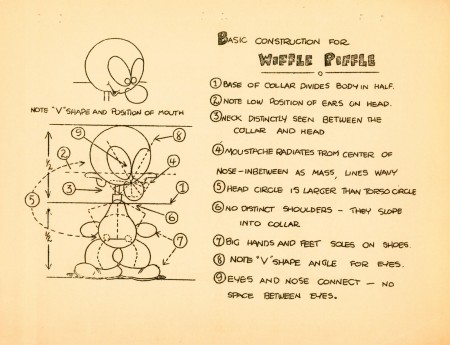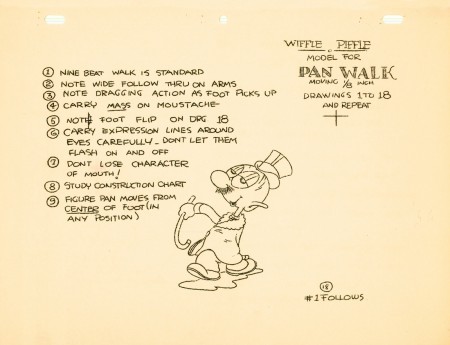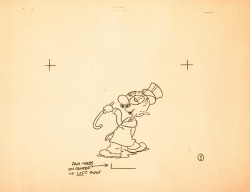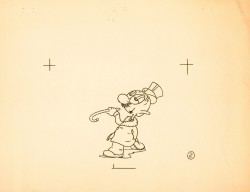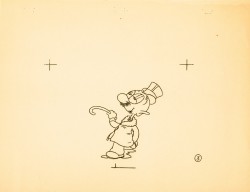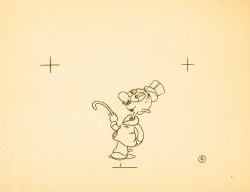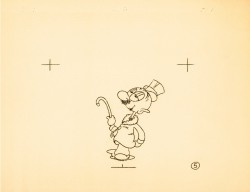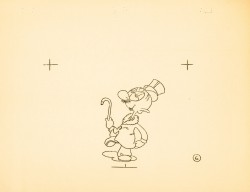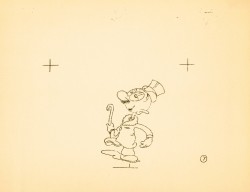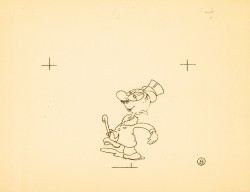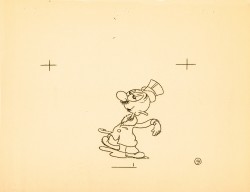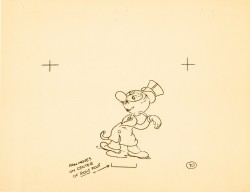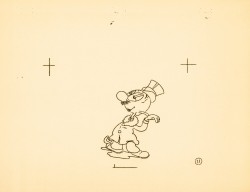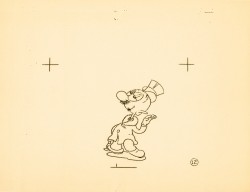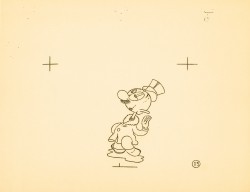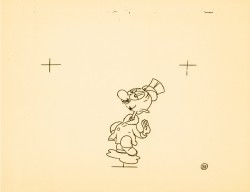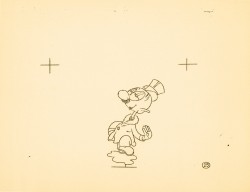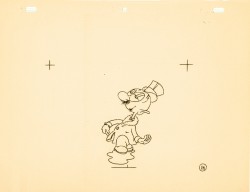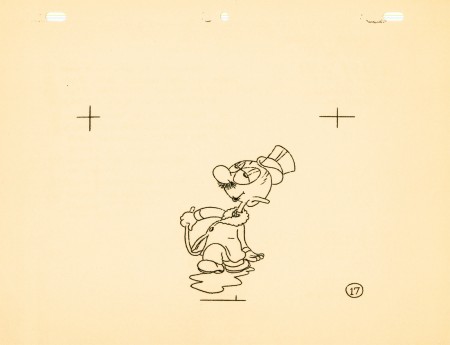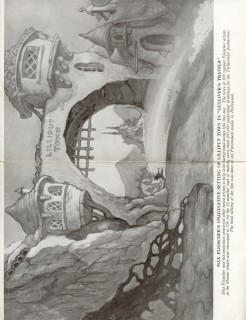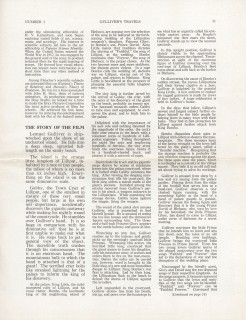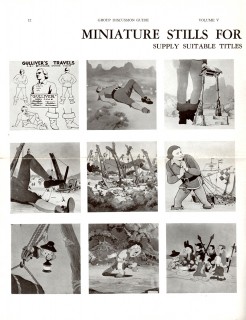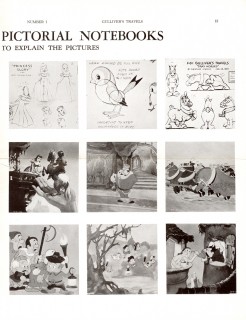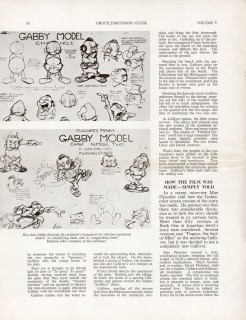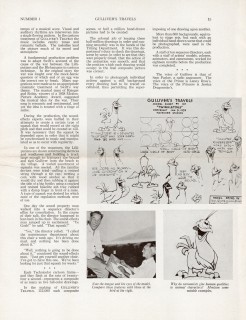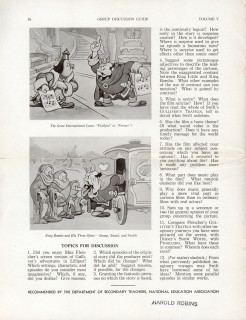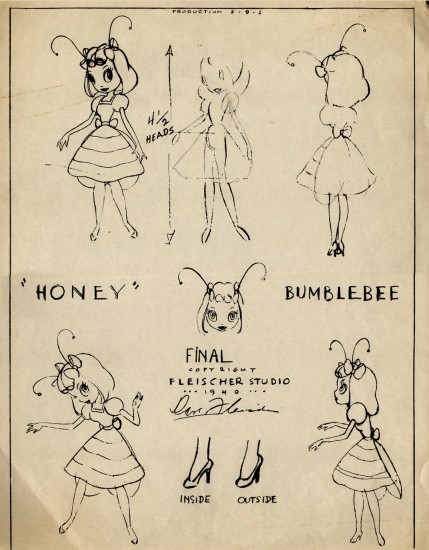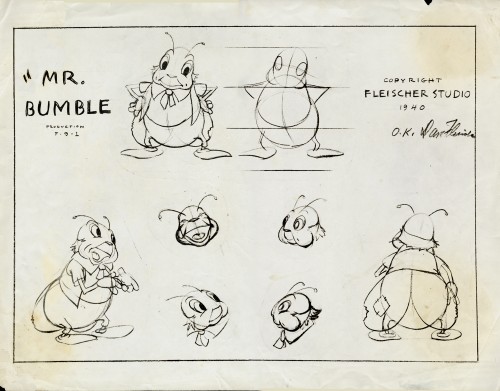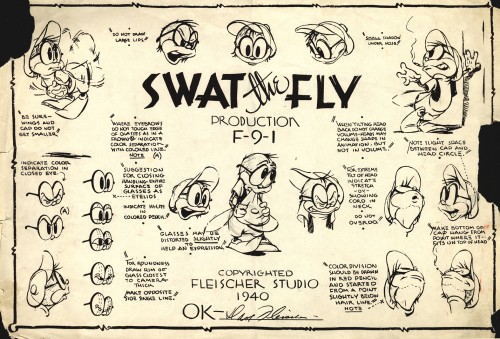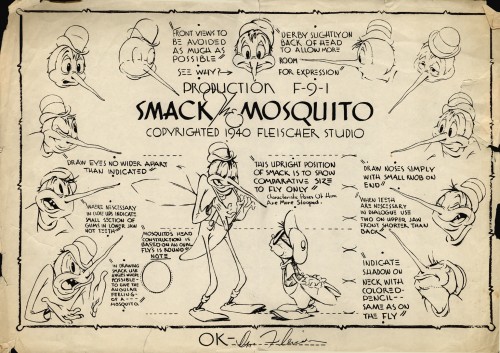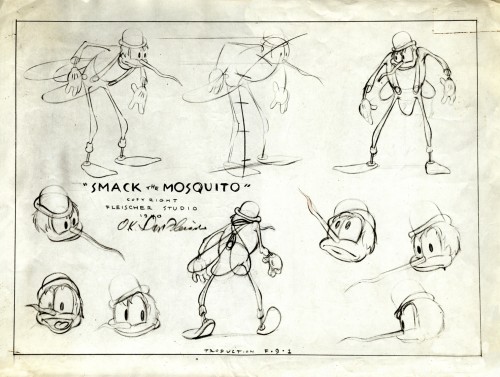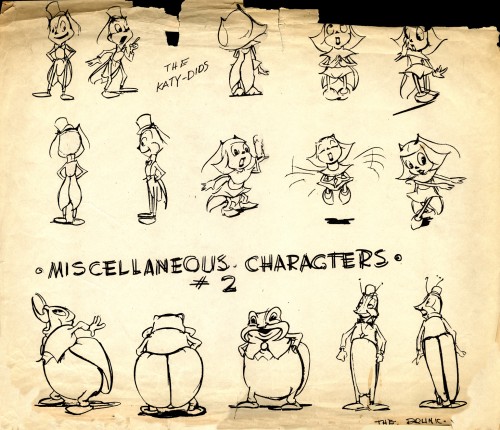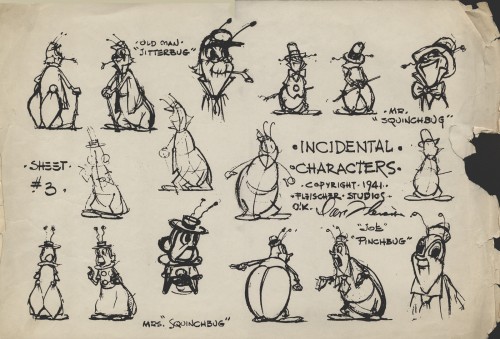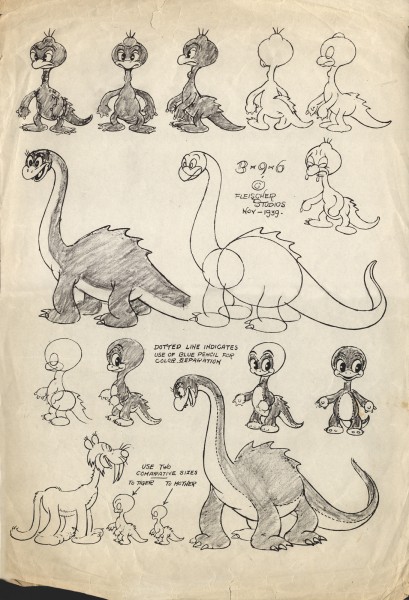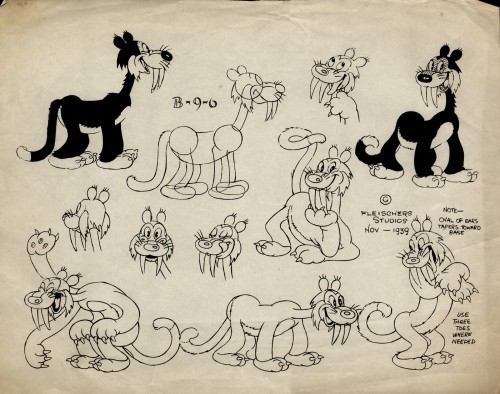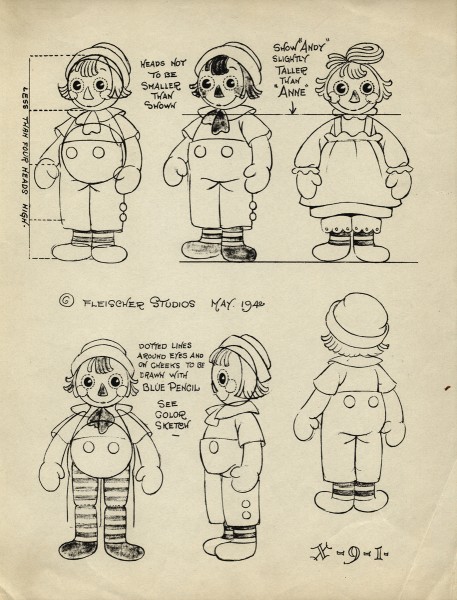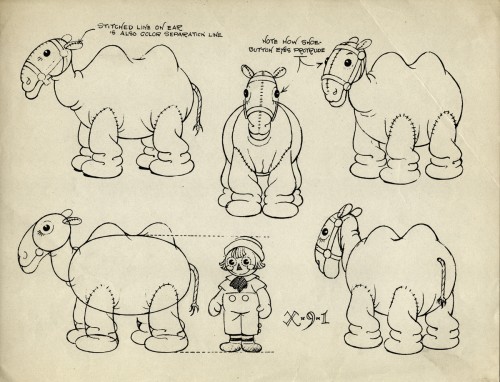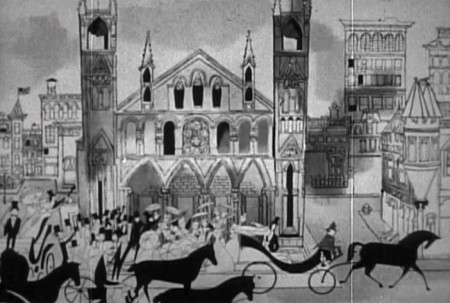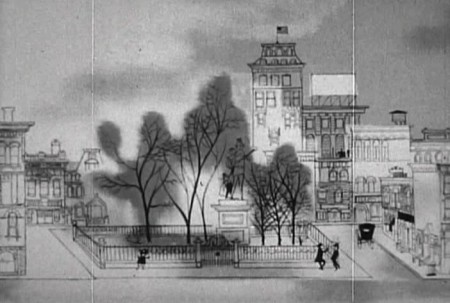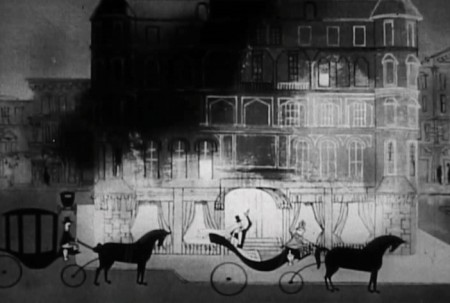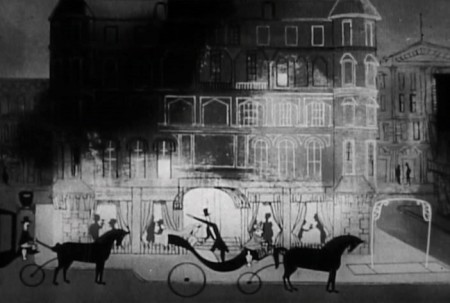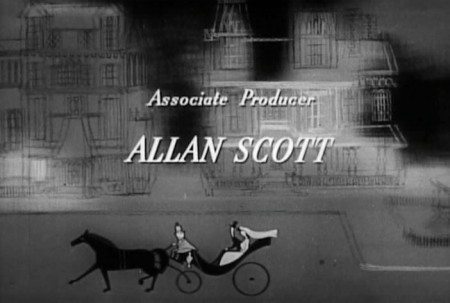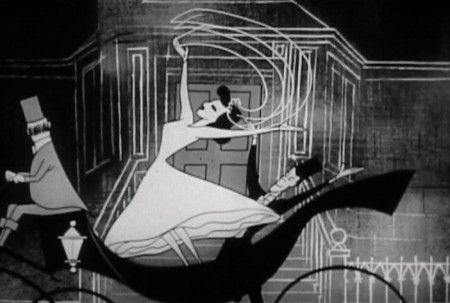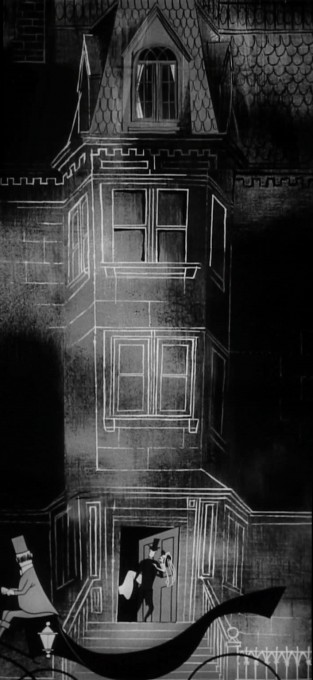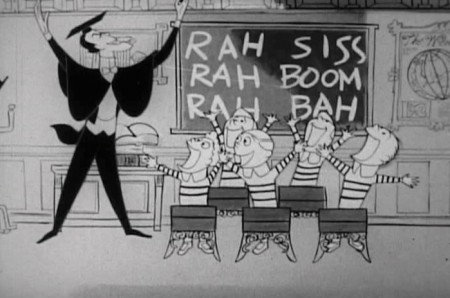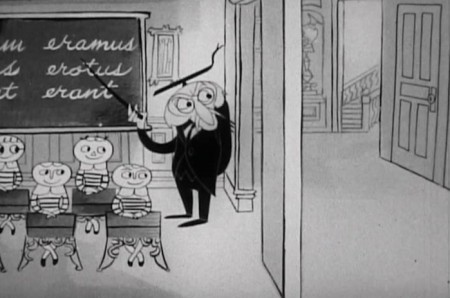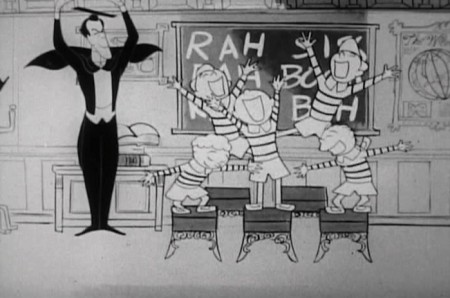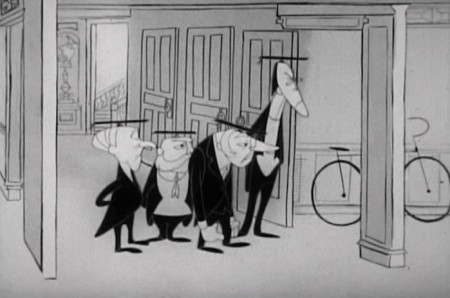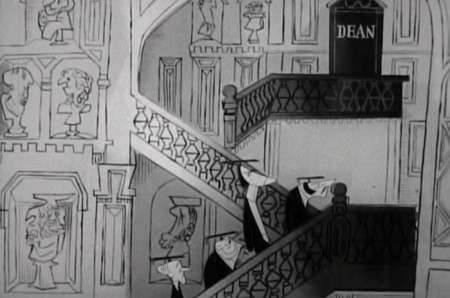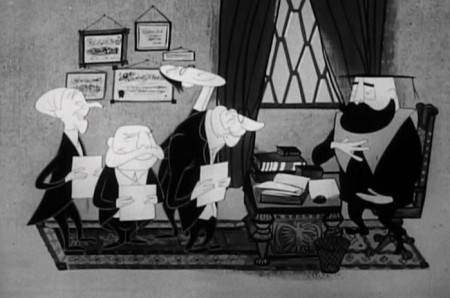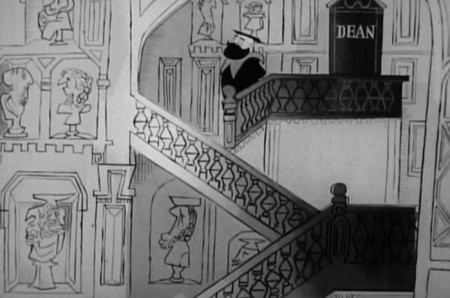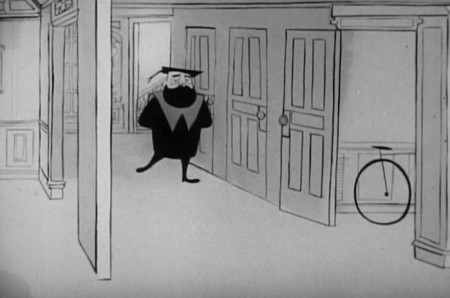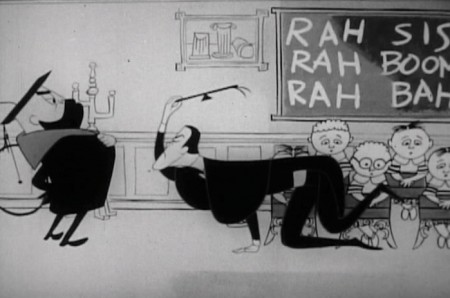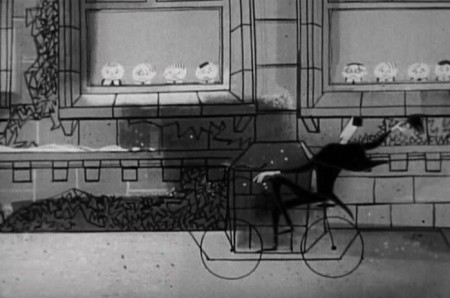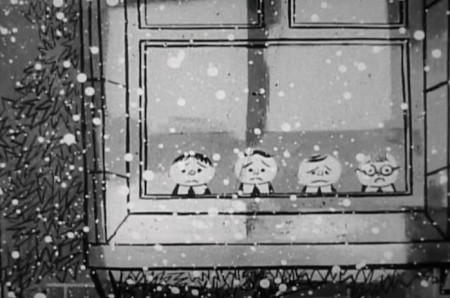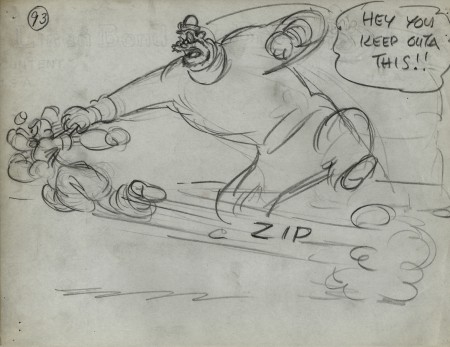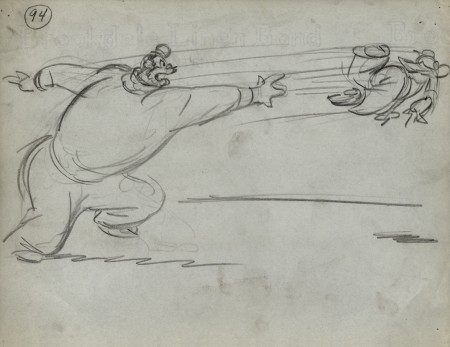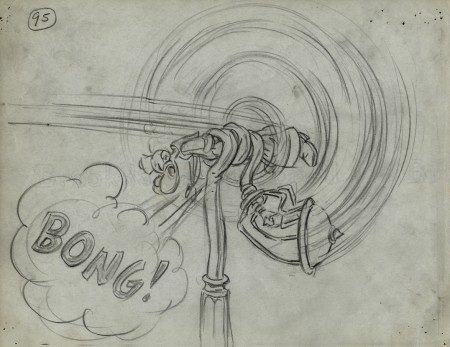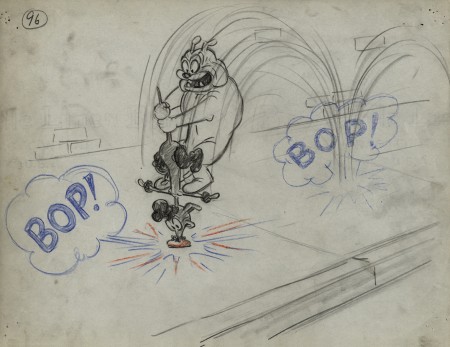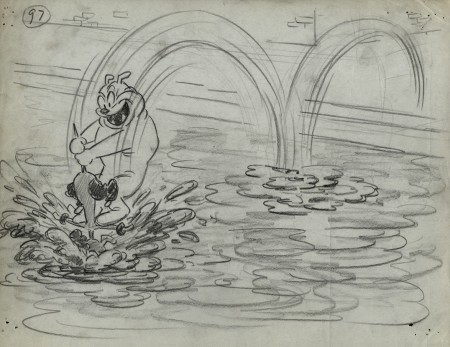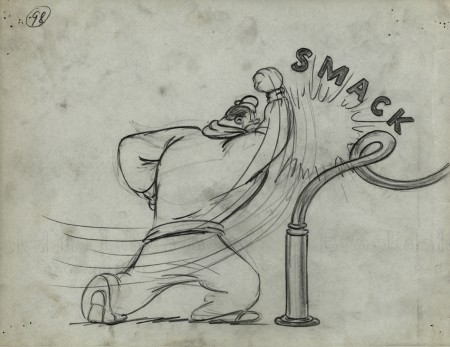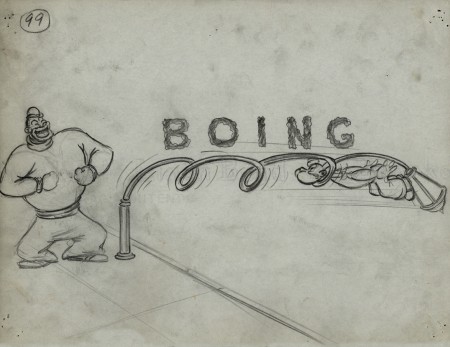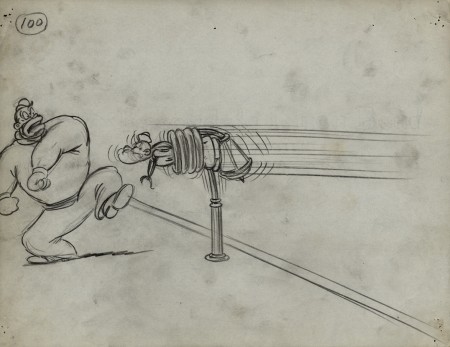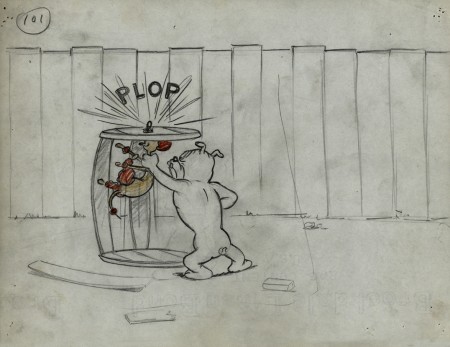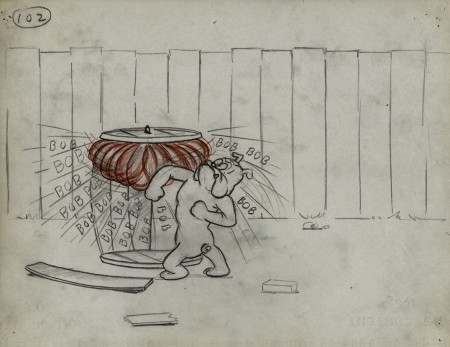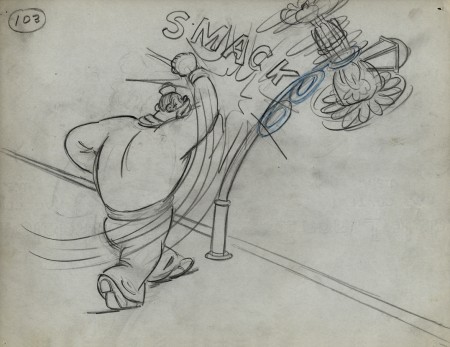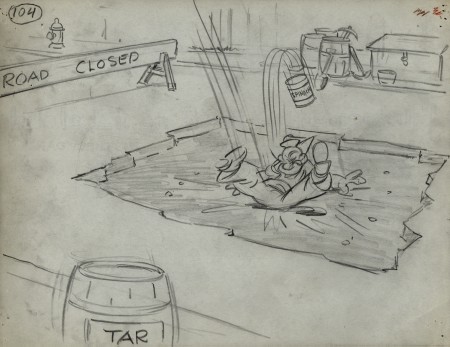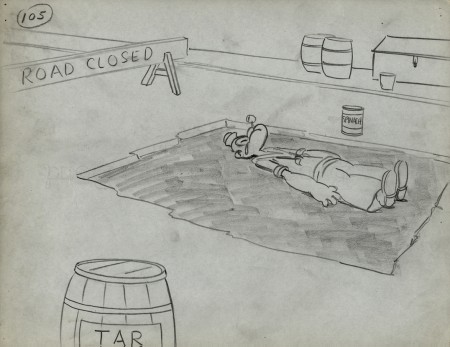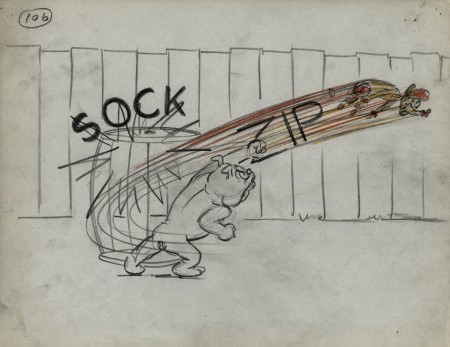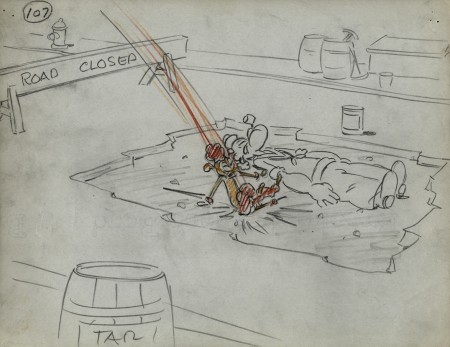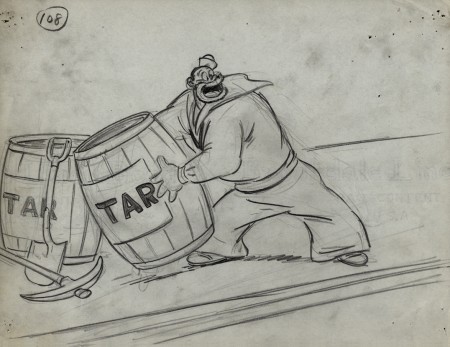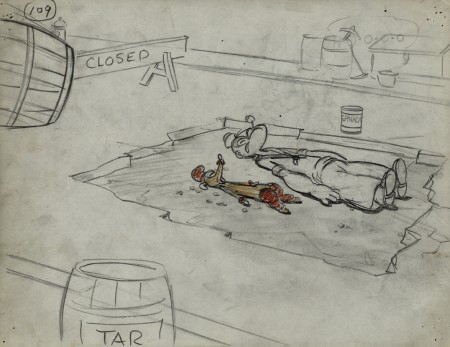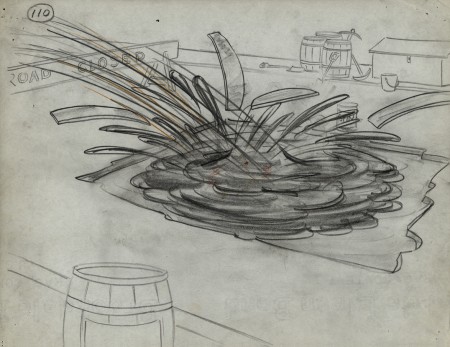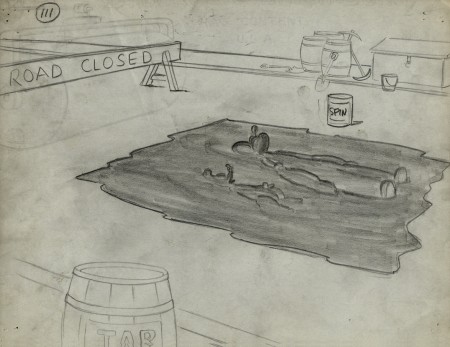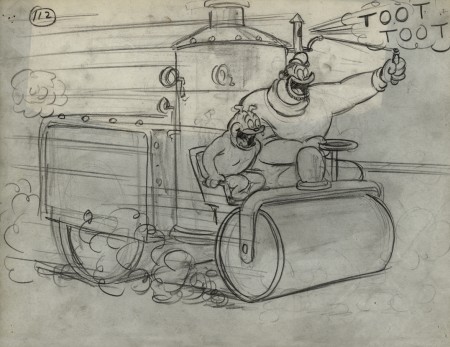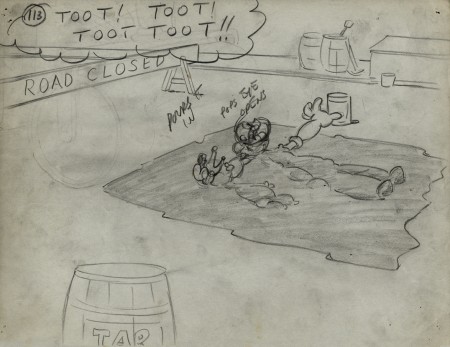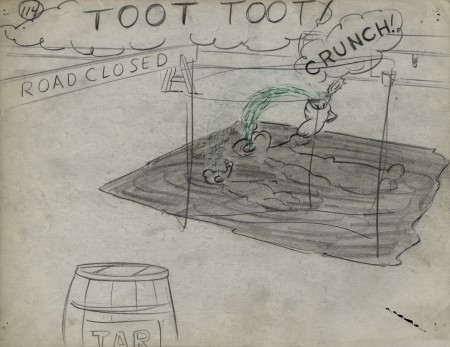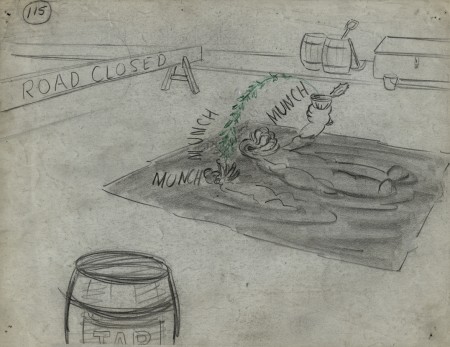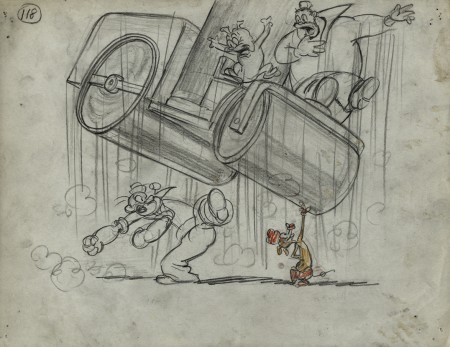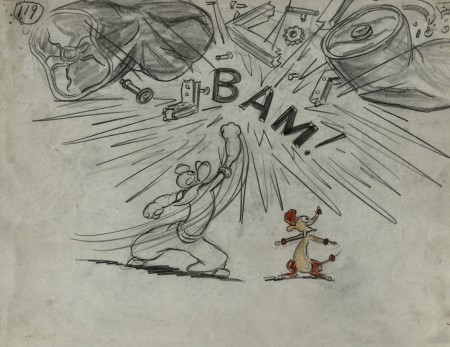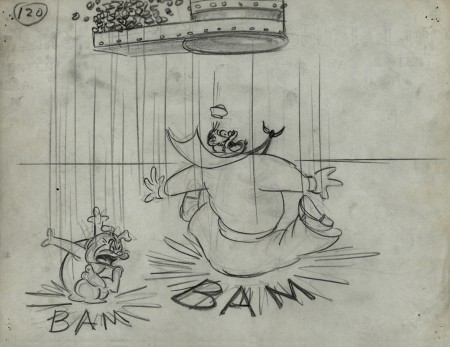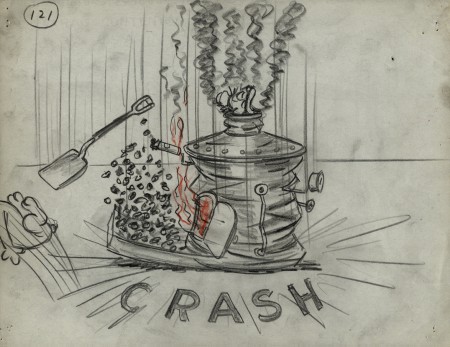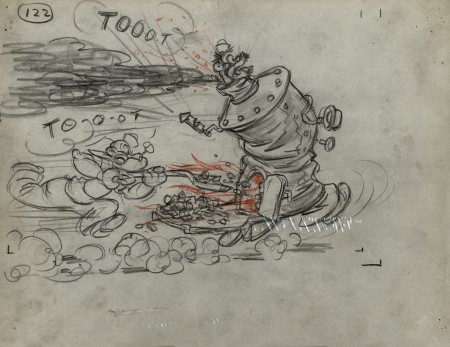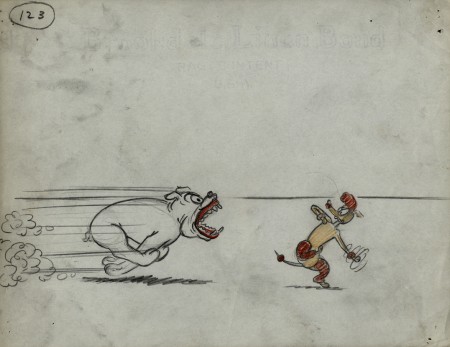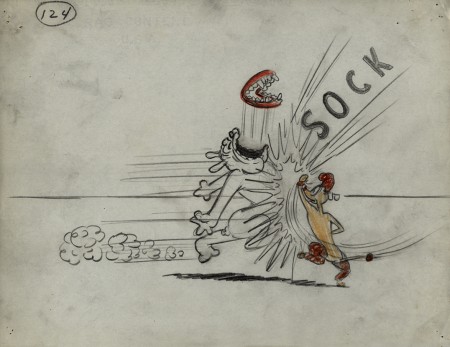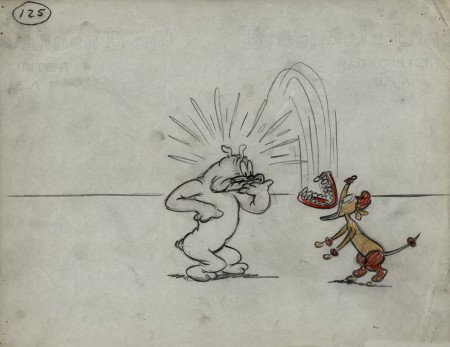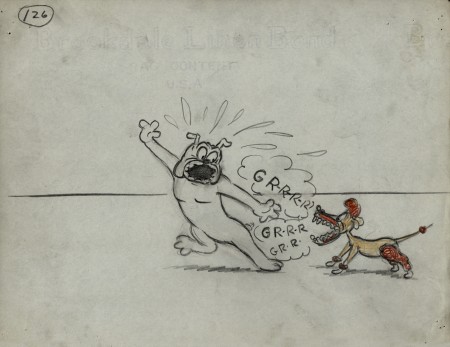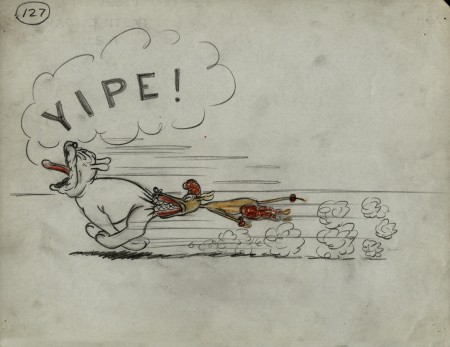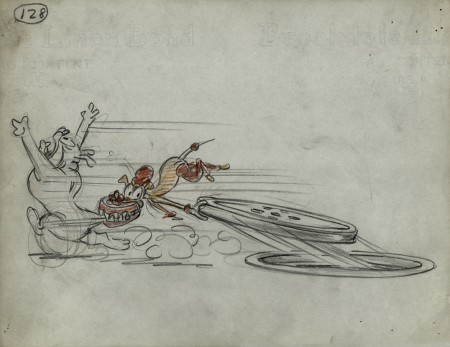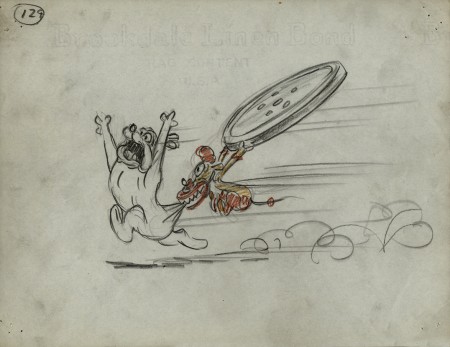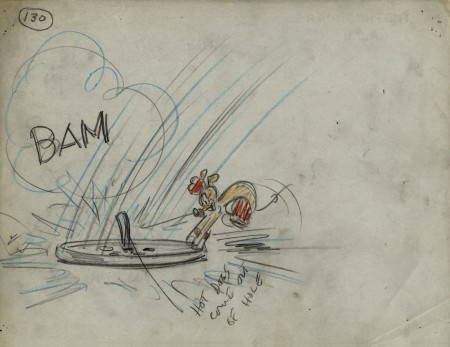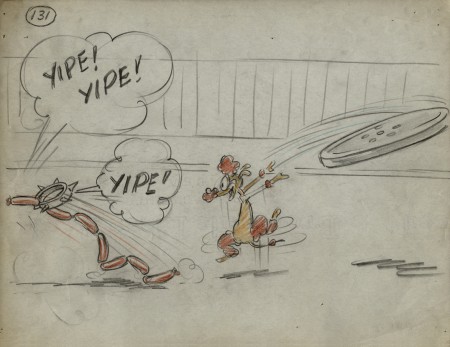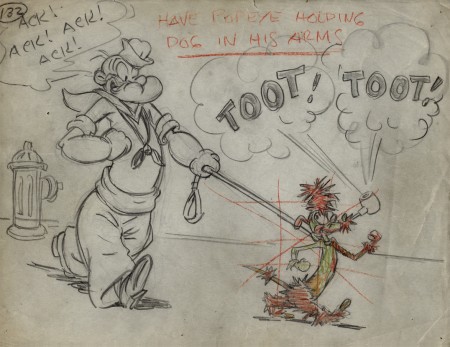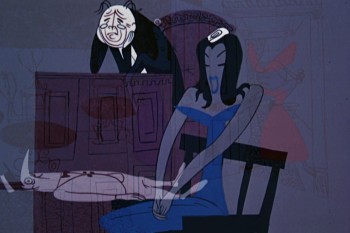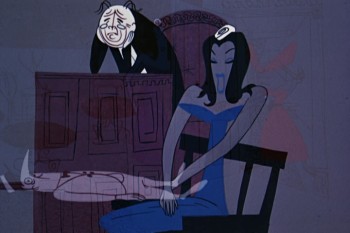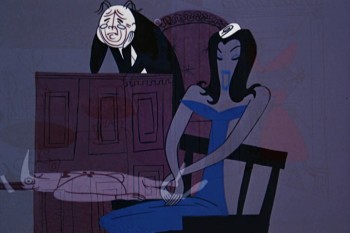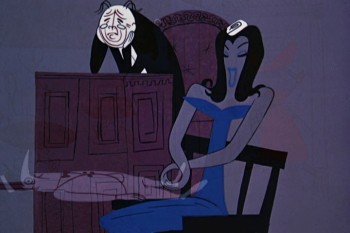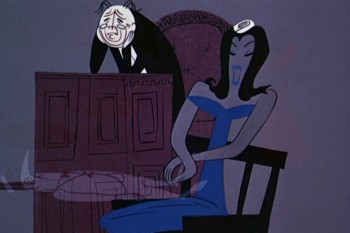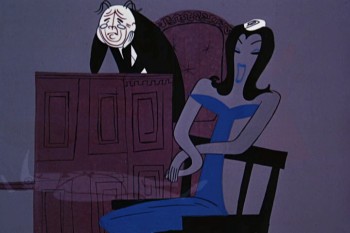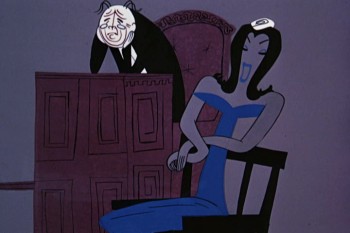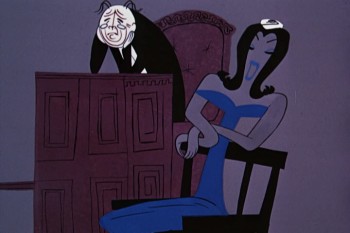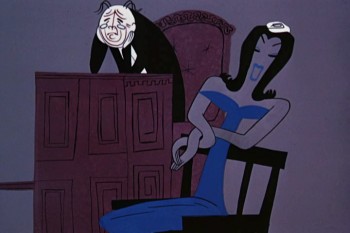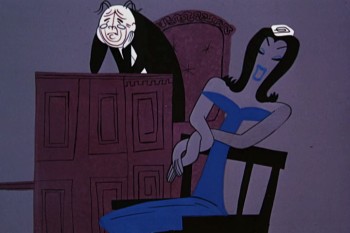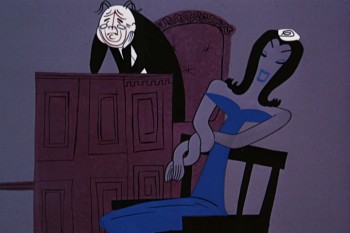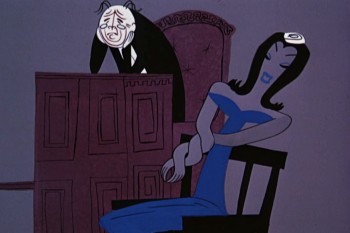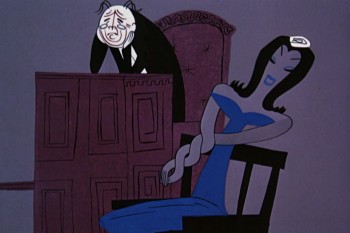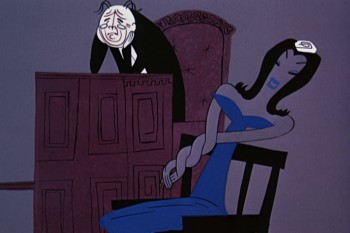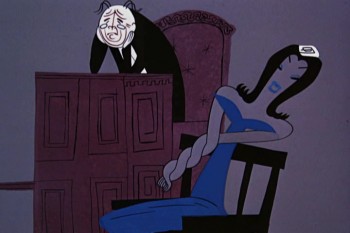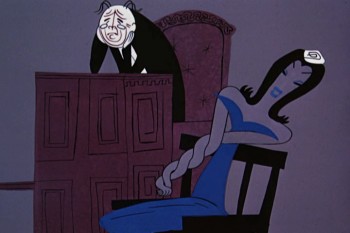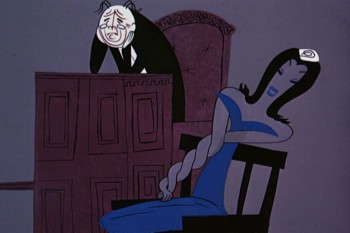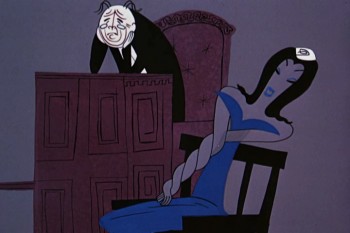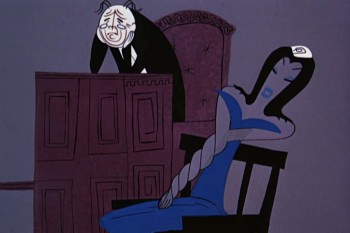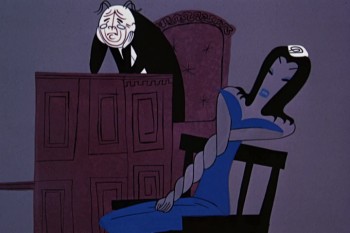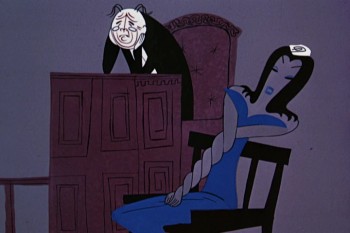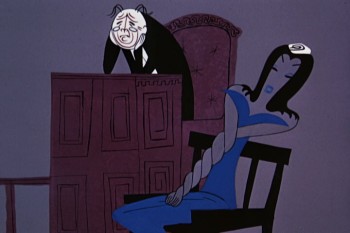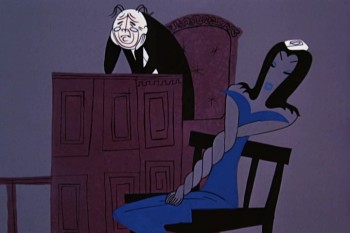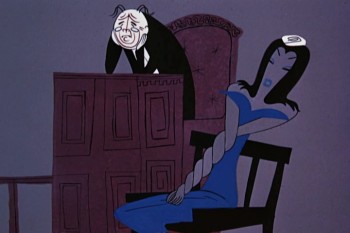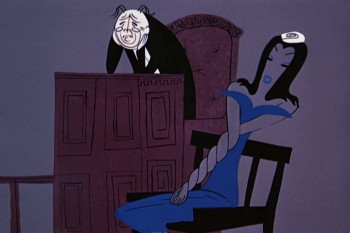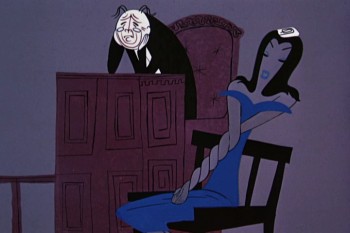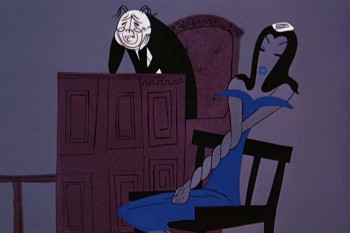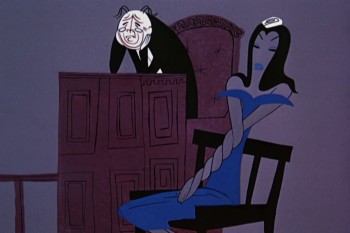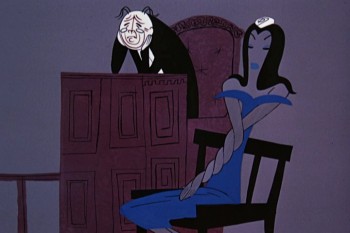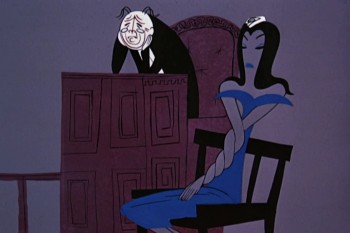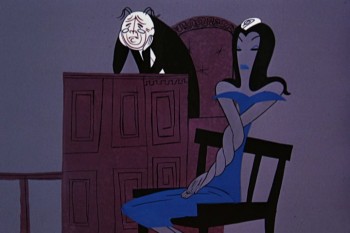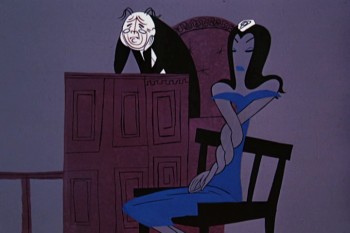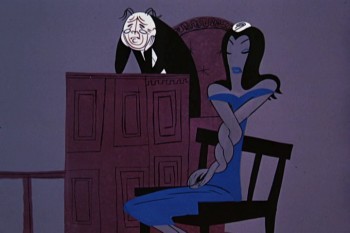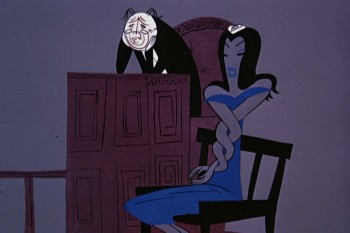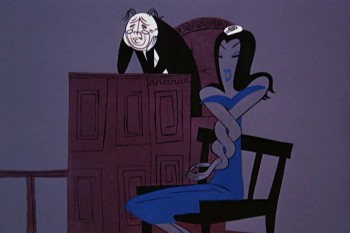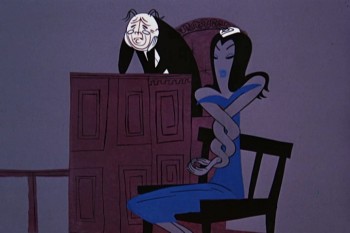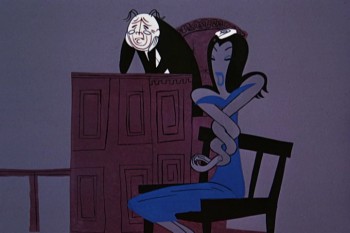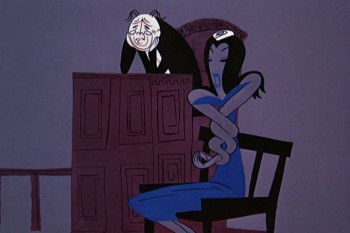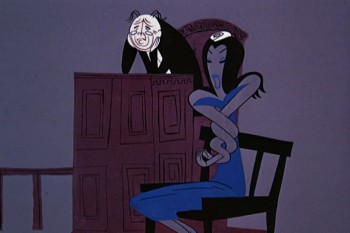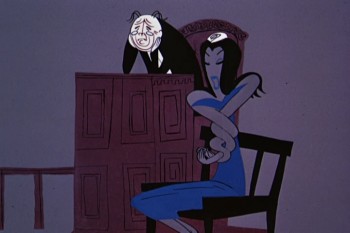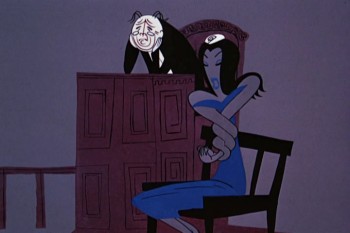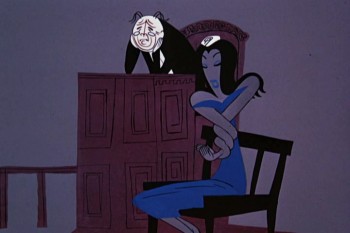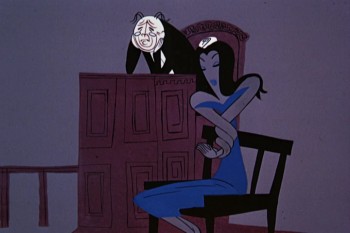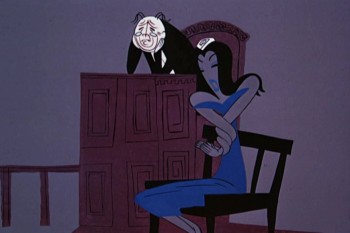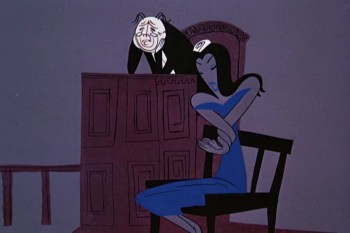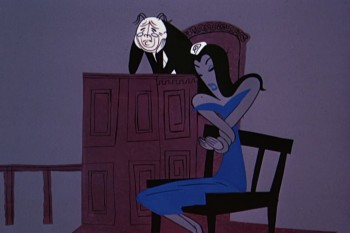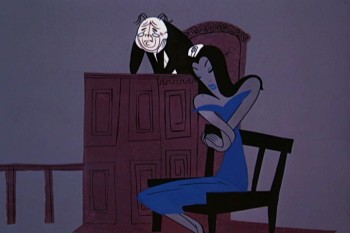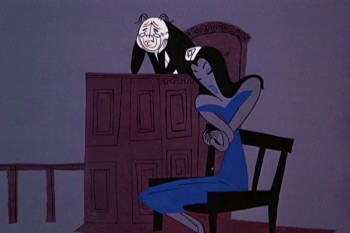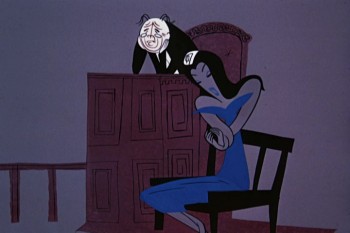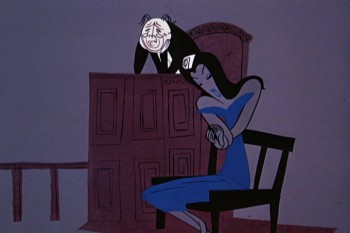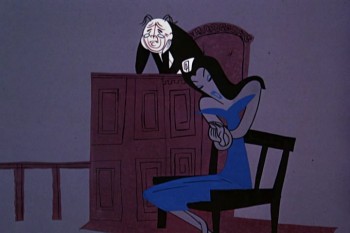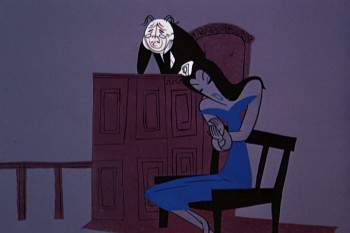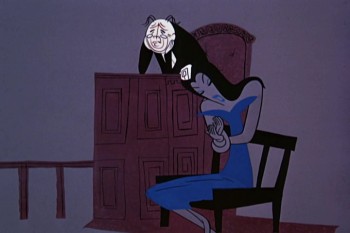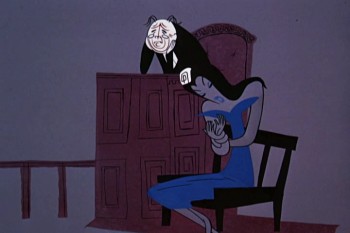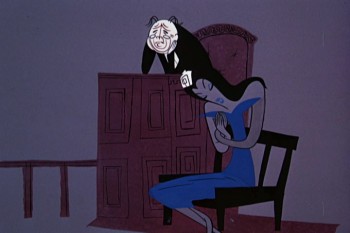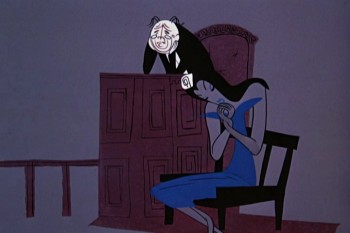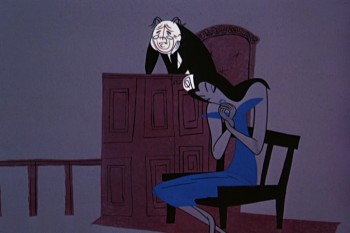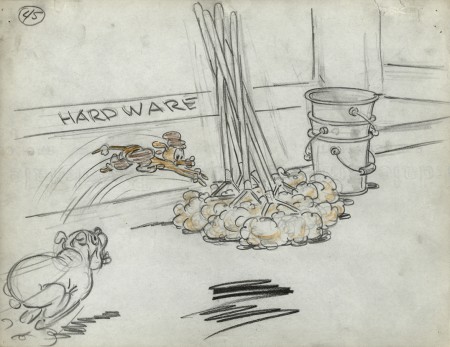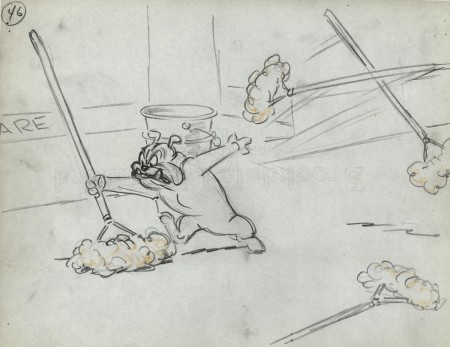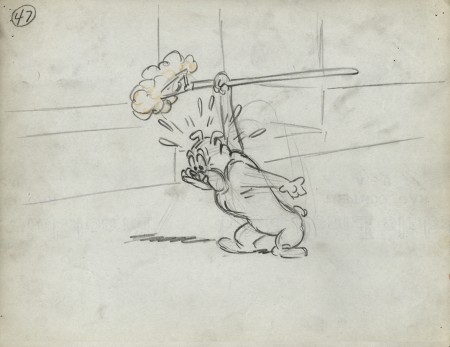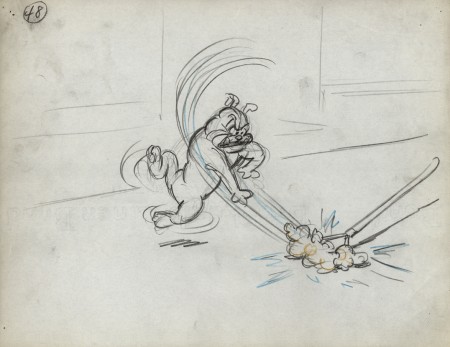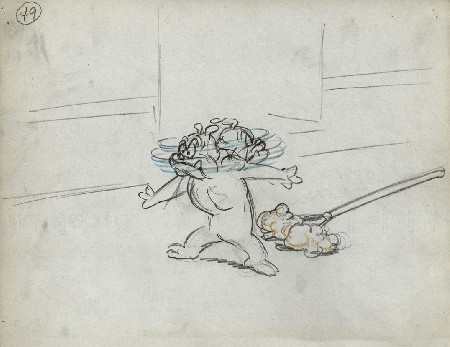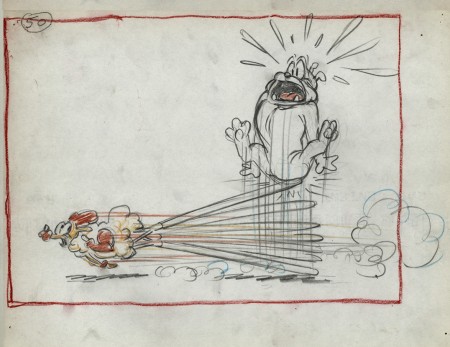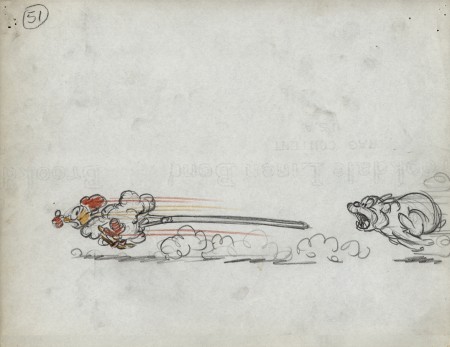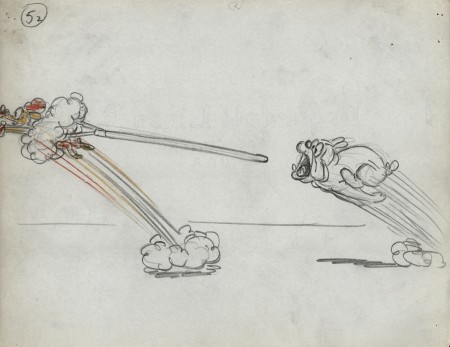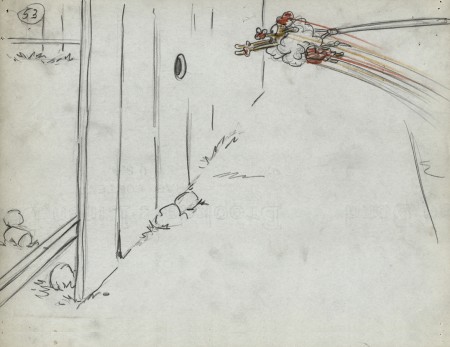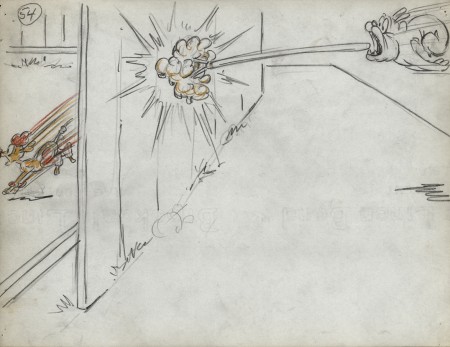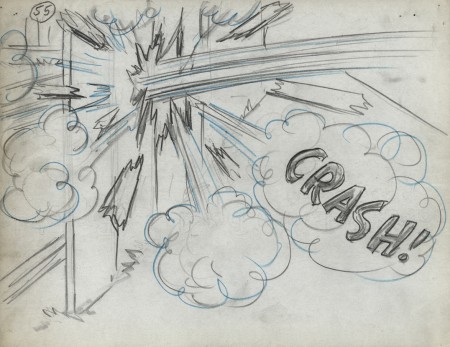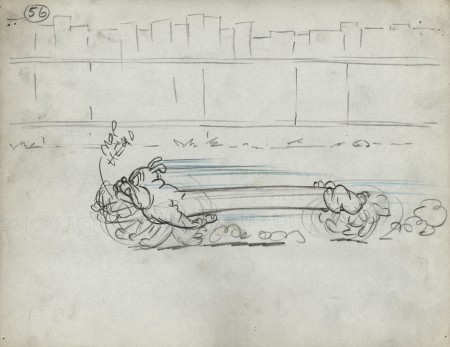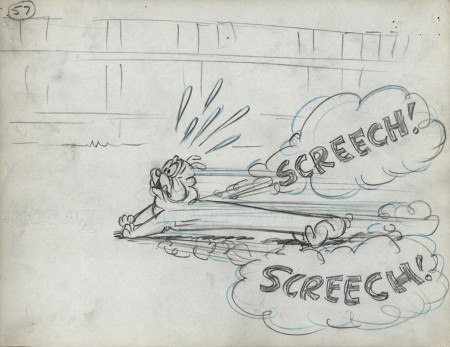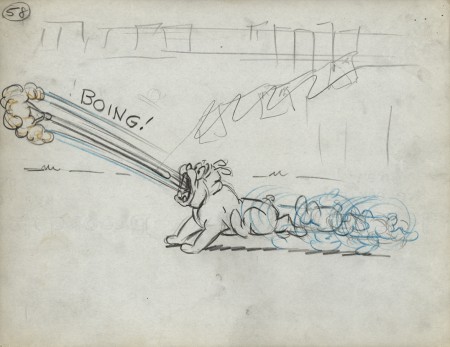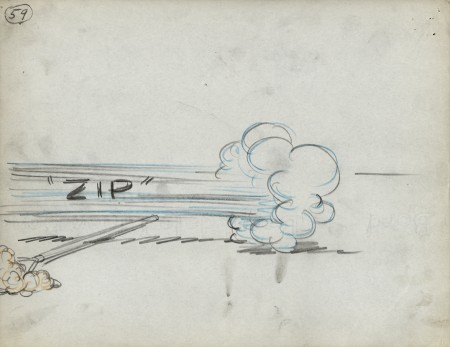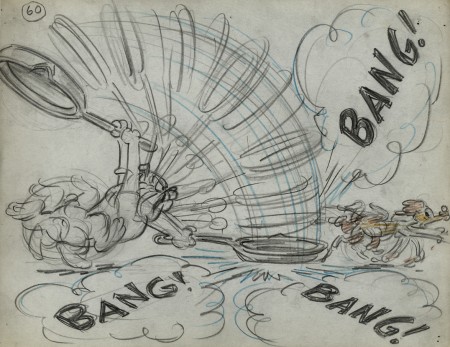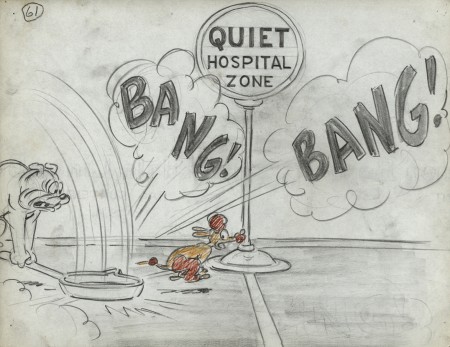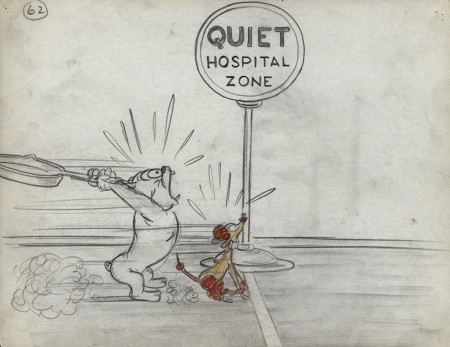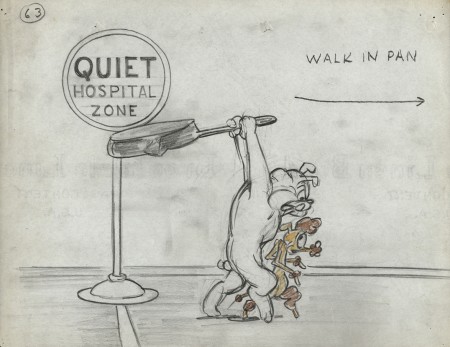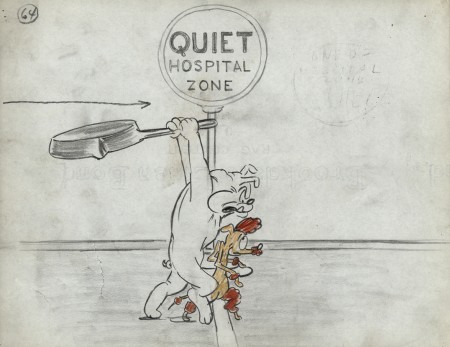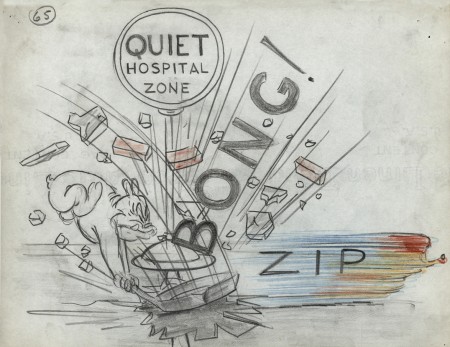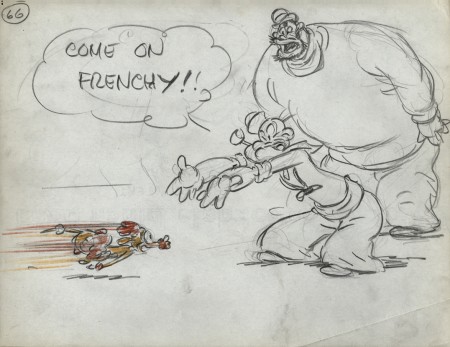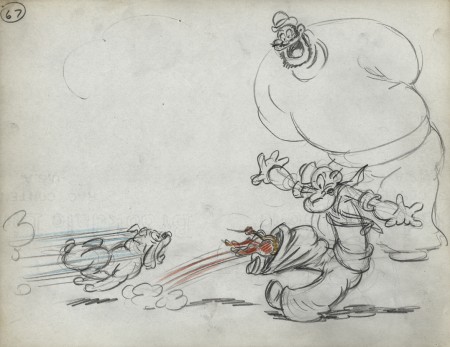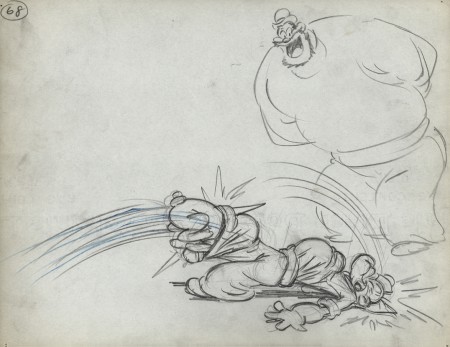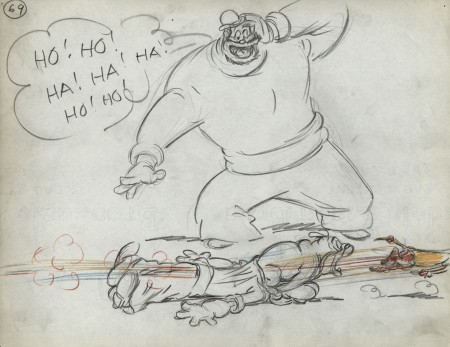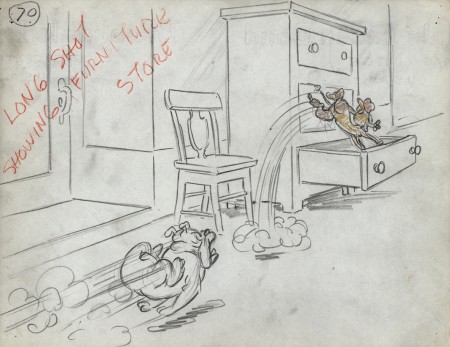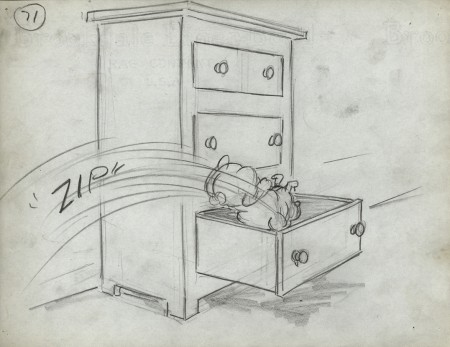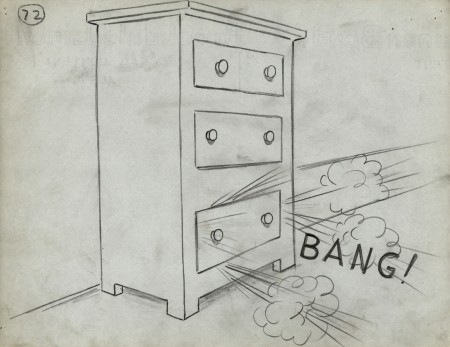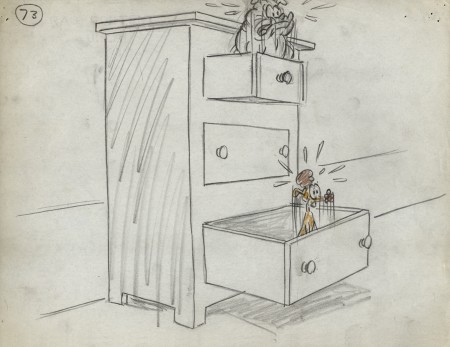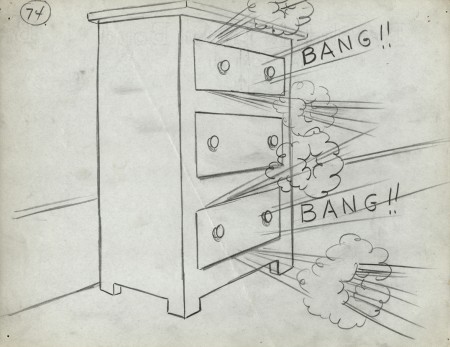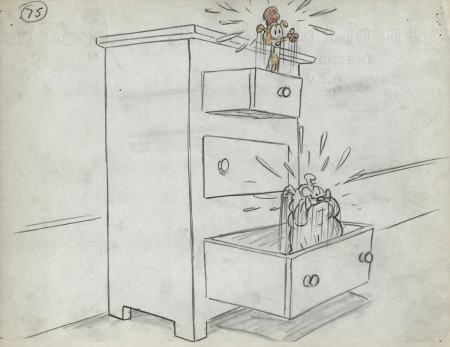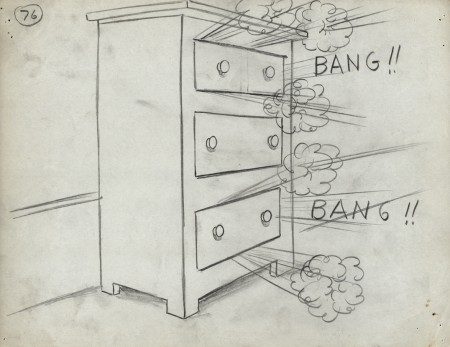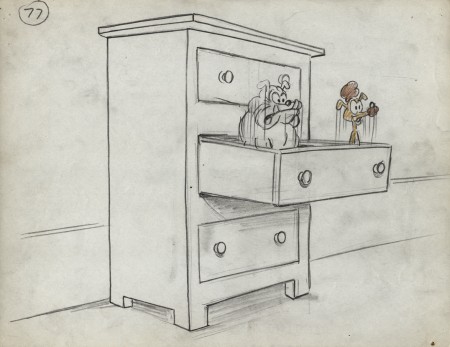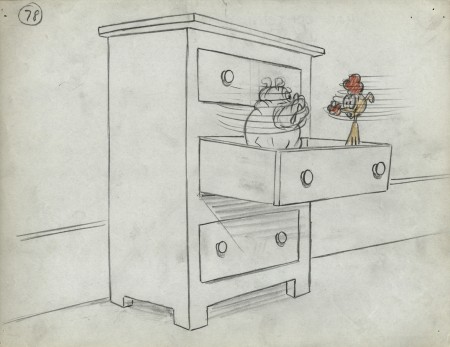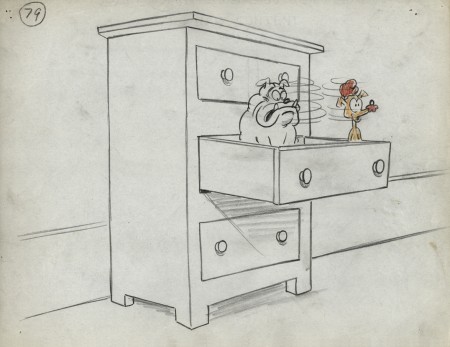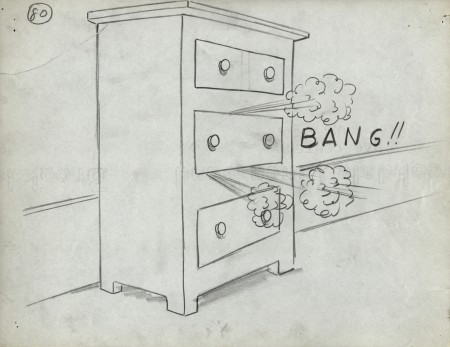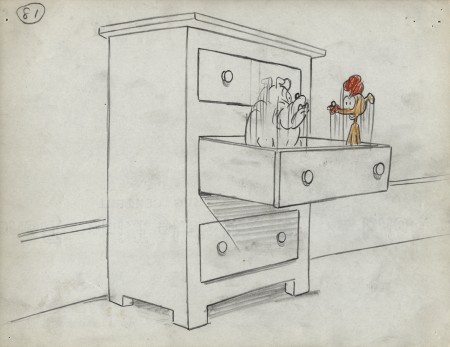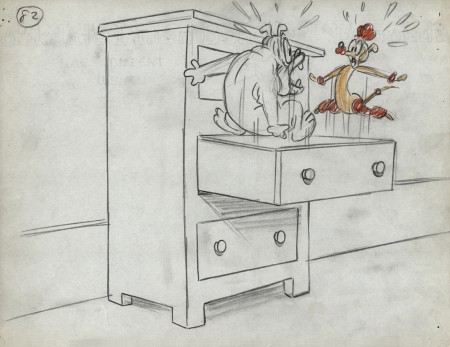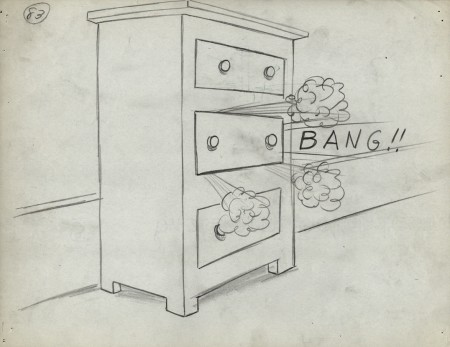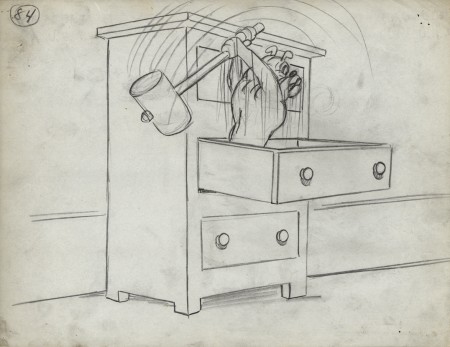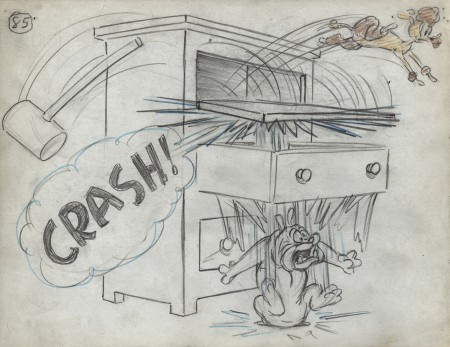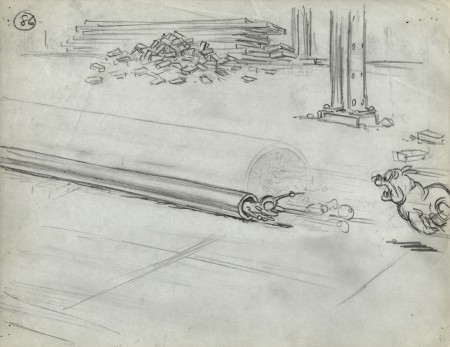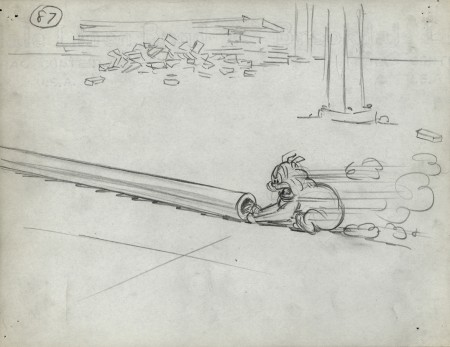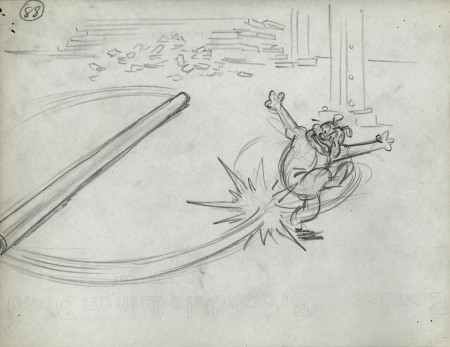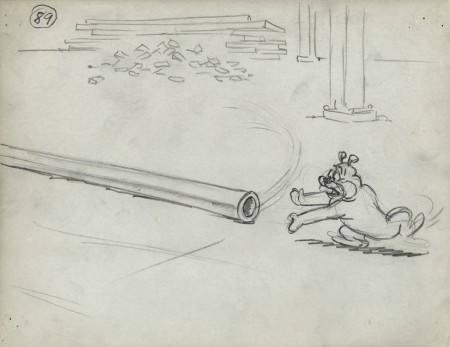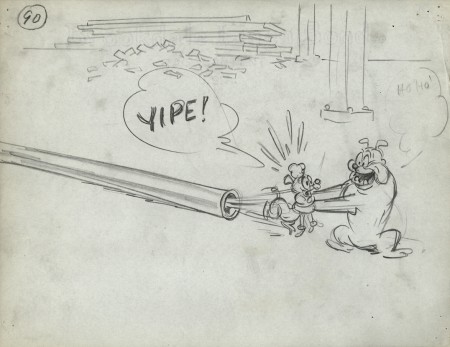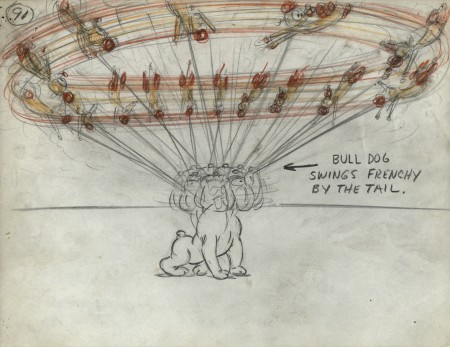Category ArchiveAnimation Artifacts
Animation Artifacts &Disney &John Canemaker &Story & Storyboards 02 Jul 2012 04:43 am
Toot Bd – repost
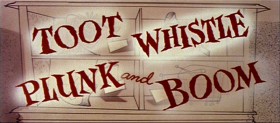 - Our Adventures in Music continue with the preliminary storyboard for what would ultimately become Toot Whistle Plunk & Boom. This is another board on loan from the archives of John Canemaker, and you can see the outgrowth from the prior film, Melody: Adventures in Music.
- Our Adventures in Music continue with the preliminary storyboard for what would ultimately become Toot Whistle Plunk & Boom. This is another board on loan from the archives of John Canemaker, and you can see the outgrowth from the prior film, Melody: Adventures in Music.
You can see how little of the magic was in this board, yet it obviously inspired others to keep it alive and make it work. Ward Kimball has to get most of the credit, though designs by Tom Oreb, Ken O’Connor, Eyvind Earle and Victor Haboush sure brought it to life.
The material I’m posting here is on large photostat copies. The problem is that the images are a bit fuzzy, and the text beneath the boards is illegible. In some cases, the appropriate text has been hand written on the copies themselves.
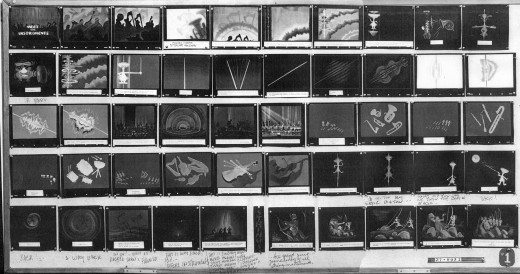 1
1
These are breakdowns of each row of the boards so that the images can be made as large as possible. Each row of images is split in two and labelled accordingly. #31a means Board 3 row 1 part a.
 11a
11a
 31a
31a
Ward Jenkins has posted some beautiful frame grabs from the completed film. Go here.
See this short on YouTube here.
John Canemaker deserves all the kudos he gets for lending this material to me as well as plenty more that he’s loaned this blog.
Animation Artifacts &commercial animation &Illustration &Photos 01 Jul 2012 06:08 am
Animator Photos
- I love shots of animation people at various functions. It’s particular fun when you know the people and the pictures show them from a different time and place. Here are a few that nicely fill the bill.
- Ralph Bakshi was in touch after seeing the Fleischer model sheets that I posted. He sent me a photo from the early 1960s.
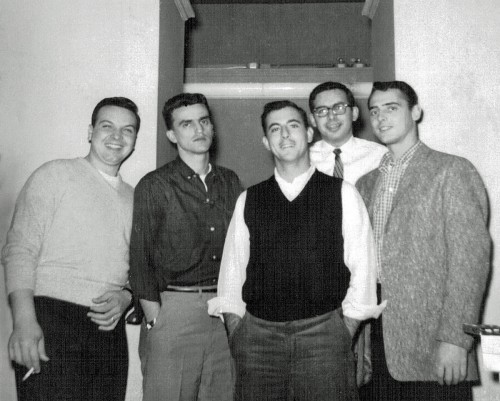
(L to R) Al Chiarito, Vinny Bell, Arnie Levy, Nick Alberti, Bill Ackerman
Candy Kugel had a couple of other photos from two events. The first two are from a Lcl 841 u-nion meeting. Candy and I tried to ID the people in the photos, and we’ve named a number of them. If you notice an error or can name some others, please just drop a note in the comments.
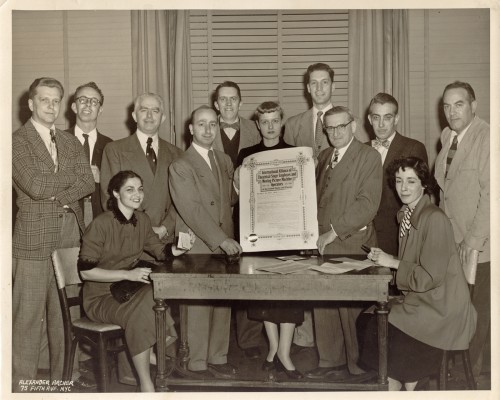
(L to R) Cliff “Red” Augustin, unknown, Izzie Klein,
Marsha Kaplan (seated), Johnny Gentilella, Gordon Whittier,
female center unknown, unknown, unknown, unknown,
unknown woman seated, Nick Tafuri
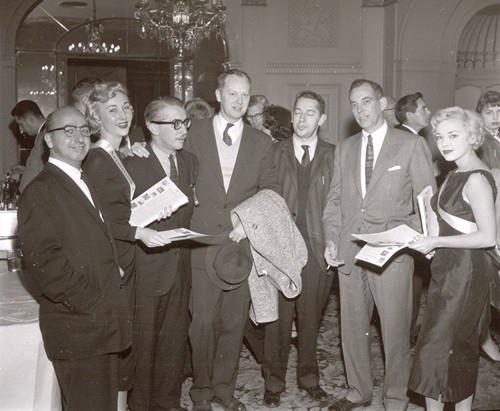
Johnny Gentilella (L), unknown fem, Pepe Ruiz,
unknown, unknown, Gordon Whittier, Unknown fem.
Other photos are from an exhibition of animation art and screenings from the different commercial studios in NYC. This was held in April 1952.
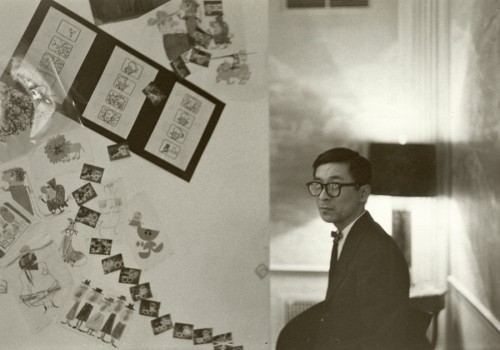
Pauk Kim was the artistic designer of the exhibition.
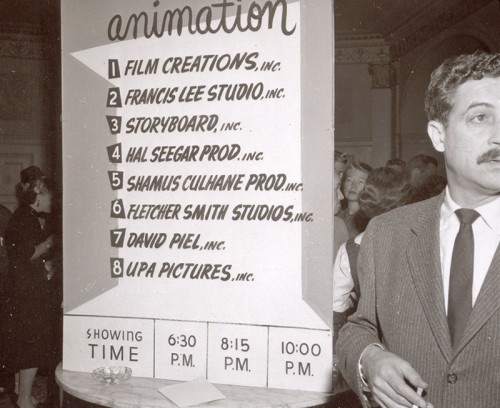
This is Lu Guarnier in front of a sign which lists
all the studios at the time that participated in the
exhibit of cels and artwork – and a screening of spots.
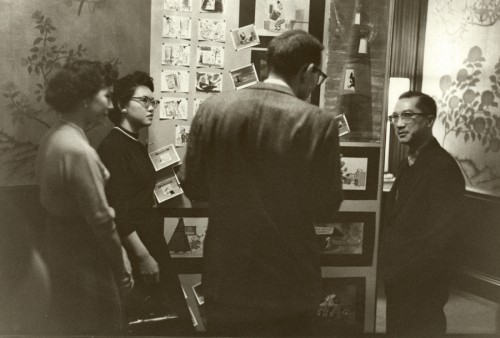
Rose Eng (?), Anne Eng (Fred’s wife), unknown visitor, Fred Eng
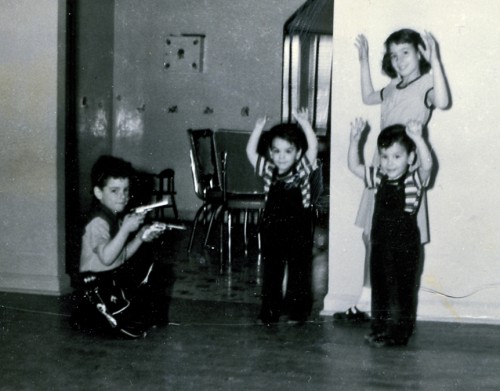
And at the very same time these animators were being
photographed at the animation function, I was holding up
my twin brothers and older sister dressed in my cowboy garb.
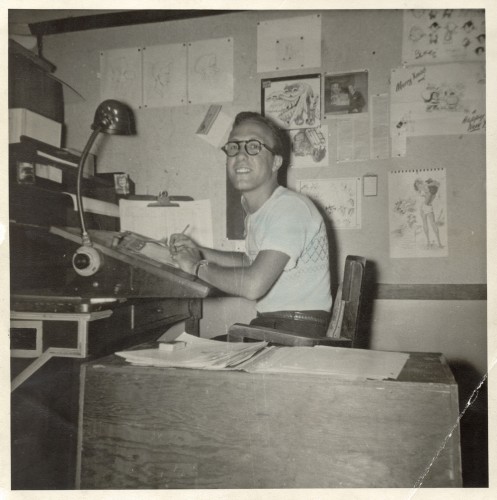
Among Candy’s photos was this one of an inbetweeener,
Fred Diamond, at his desk in Famous Studios. I thought
it interesting to see what the setup looked like at Famous.
Finally here’s a picture of Assistant Animator, Gerry Dvorak, who painted baseball cards in his early days, then went into pictures of snow leopards.
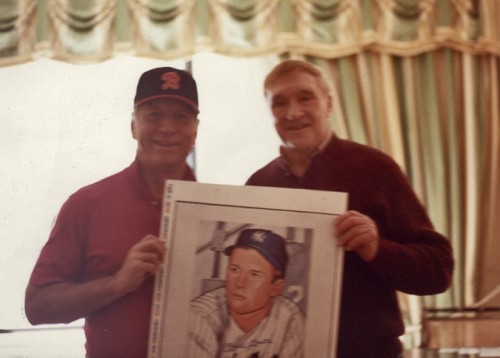
This is Gerry posing with Mickey Mantle at Mantle’s hotel room.
They’re holding up Gerry’s baseball card painting of Mantle.
____________________
Animation &Animation Artifacts &Fleischer &Models 24 Jun 2012 05:33 am
Wiffle Piffle – repost
This character is really every thing you need to know about Fleischer animation. Animated by Tom Johnson the guy’s alive, and he’s nothing more than a wacky cartoon character. He couldn’t be anywhere else. Where’s the cgi equivalent? Oh that’s right; it couldn’t exist.
Time to post it anew.
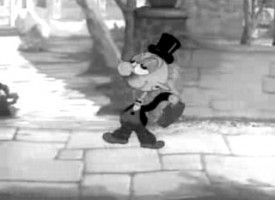 - Wiffle Piffle was a character that the Fleischer studio tried to develop out of the Betty Boop series. The first appearance was in a Screen Song: I Feel Like A Feather In The Breeze released in 1936. He appears as a waiter in the opening. The animation of the character was by Tom Johnson (as was this model sheet.)
- Wiffle Piffle was a character that the Fleischer studio tried to develop out of the Betty Boop series. The first appearance was in a Screen Song: I Feel Like A Feather In The Breeze released in 1936. He appears as a waiter in the opening. The animation of the character was by Tom Johnson (as was this model sheet.)
Two follow-up films were made with this side character in Betty Boop shorts.
The first, released in February 1937, was Whoops! I’m A Cowboy, and the second, in March 1937, The Hot Air Salesman. The opening scene features an expensive multiplane shot behind him.
He seems to have been an Egghead type character whose sole character trait was a silly walk. Needless to say, they couldn’t find a job for him.
The model sheet for the character was an 18 drawing walk cycle with a bit of a turnaround. Cross-hairs keep the character in registration; only a couple of the pages were punched.
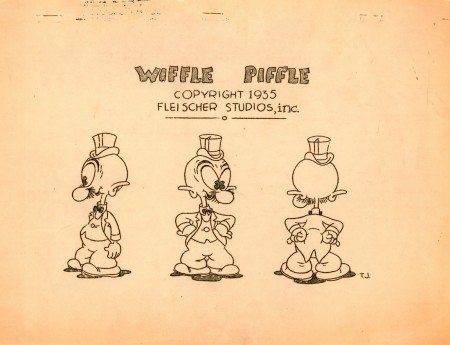 Wiffle Piffle walk cycle
Wiffle Piffle walk cycleOn ones at 24FPS
Click left side of black bar to play.
Right side to watch single frame.
Animation Artifacts &Fleischer &Layout & Design 20 Jun 2012 05:36 am
Paramount Bgs & Gulliver Teaching Aid
- For the past few weeks, I’ve been posting artwork from Vince Cafarelli‘s collection of animation artifacts. We’re coming down to the remainders in this box, and I’ll post most of it. There are a few color Background originals.
At first viewing, I thought these were possibly from Terrytoons, (here is a past post I did of Terry Backgrounds I own from the late Thirties) but they have a slickness that Terry Backgrounds wouldn’t have had. They also lack any sign of the glorious whimsy the Fleischer Backgrounds had. These, no doubt, come from Late 40s Paramount cartoons when Bob Little was the principal artist. There’s ample use of airbrush over the bright tempera colors. (I don’t remember seeing airbrush in any Terry cartoons of this period.) Physically, they were all done on bristol board and separated from the card back. This is also true of all the Terrytoons Backgrounds I’ve seen.
I’m sorry to say that I can’t ID any of these Backgrounds or tell you what films they’re from. Were I able to do that we might have been able to figure out who did them. If you know anything about them, anything at all, your comments would sure be appreciated, and I’ll keep updating the post to make sure they’re noted.
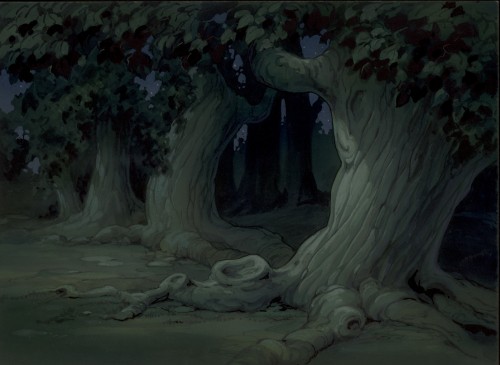 1
1This first one does a nice job of setting the mood for the scene.
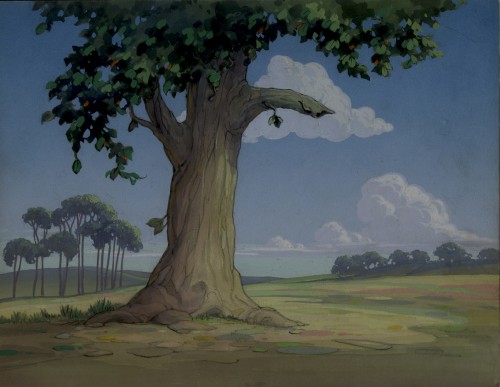 2
2
from Song of the Birds
This one doesn’t really do much other than be a background.
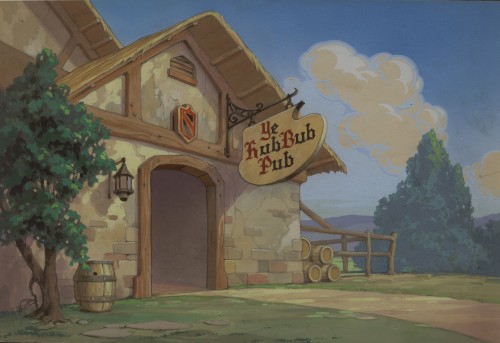 3
3
from Robin Hood-Winked
This tavern really does set up the scene. As a matter of fact,
it’s so specific it should be one of the easiest to identify.
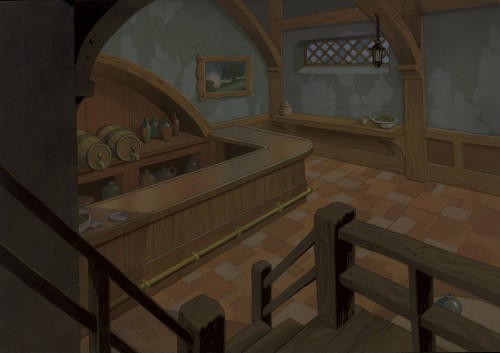 4
4
from Robin Hood-Winked
This interior is also more specific than most of the
Paramount Bgs of the period and feels as though
it may have come from the same film as the tavern, above.
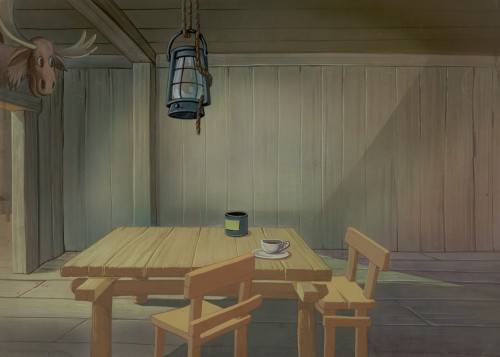 5
5
from Lumberjack and Jill
This one is so generic it may have come from any of a hundred
films of the period. It’s the Bg that felt like a Terrytoon to me.
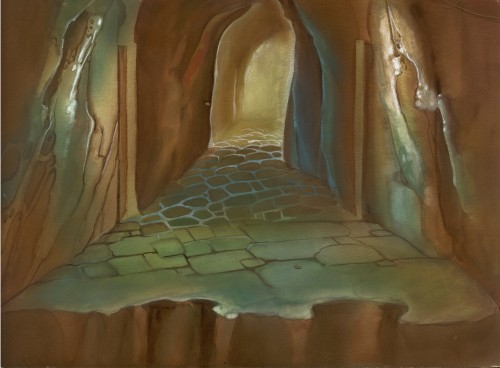 6
6
This Bg feels closer, stylistically, to #4, above,
than to #5. There’s a lot of airbrush in it.
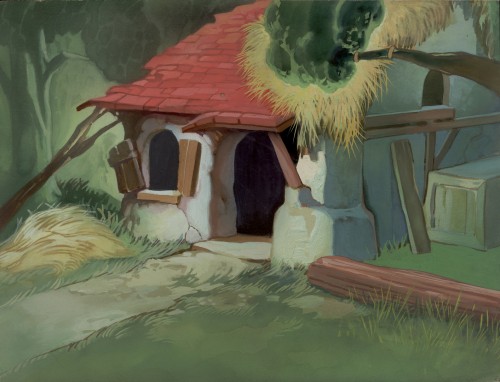 7
7
This Bg seems to have some chalk used on the white stone
of the building’s exterior. It reminds me of several other
Disney Bgs – not as good as Disney, but similar in feel.
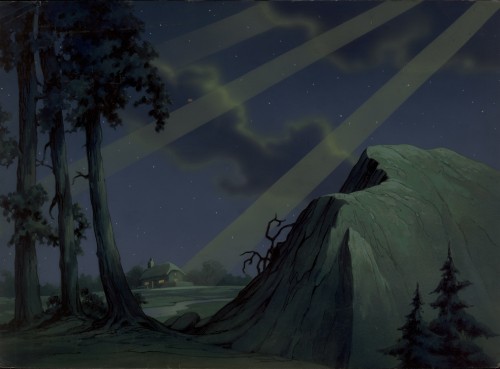 8
8
from Leprechaun’s Gold
Who knows what this Bg is. I guess god’s
looking down on the inhabitants of the hutch.
- As a bonus to add to these Backgrounds, here’s something completely unrelated.
Today, when children’s films are distributed non-theatrically (meaning to schools and libraries) a teaching aid accompanies the film. This is usually a two or three page piece which gives information on how the film can be used to teach whatever subject to the students. This form has developed in quite a sophisticated way so that it is often very helpful to the teacher or librarian.
Within Vince Cafarelli’s collection of art and artifacts, there was a teaching aid – which seems half designed to be a give-away to students. It’s a primitive form of what is standardized today. The printing of the piece is quite rich on semi-gloss paper with nice B&W photo reproductions of stills from the film. I thought this would be of interest to some of you out there.
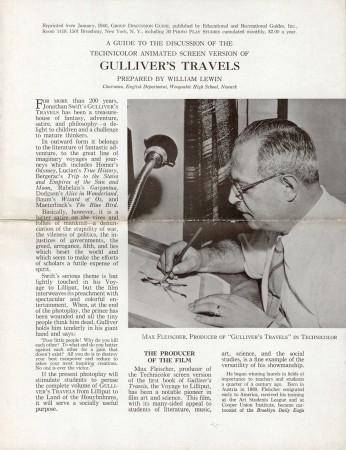 1
1(Click any image to enlarge.)
Animation Artifacts &Fleischer &Models 13 Jun 2012 05:30 am
Fleischer Model Sheets – Hoppity & friends
- I have always been a sucker for Hoppity Goes to Town. For some reason, from my first viewing in the early 60s, to tofsy, I have loved this film and everything about it. The score is magnificent, with those great Hoagy Carmichael / Frank Loesser songs, and the score by Leigh Harline is quite sophisticated; the character styling is absolutely the height of charm for Fleischer – so beautifully round -, and the animation is just bright enough to pull off the original Fleischer story. It also takes place in a recognizable New York City – something that will always win me over.
At one time I’d posted a copy of a children’s book I’d found which bounced off the film.
These are the model sheets the late Vince Cafarelli had in his collection. I would have liked seeing a Mr. Beetle or two and possibly a work sheet for how they were going to treat the rotoscoped humans. (The handling of the rotoscoped animation goes far beyond what they did in Gulliver’s Travels. There’s a nice little frame grab post featuring one of these scenes at Classic Cartoon Reviews. ) But I’m pleased to have what model sheets I do have to post. Here they are.
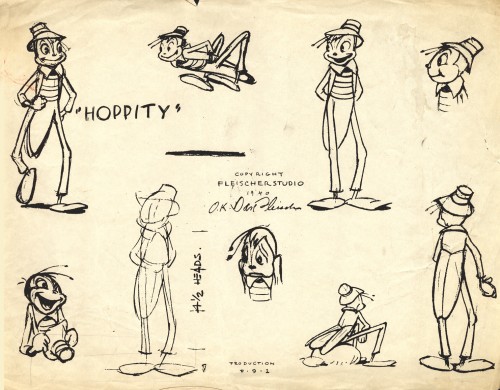 1
1Hoppity
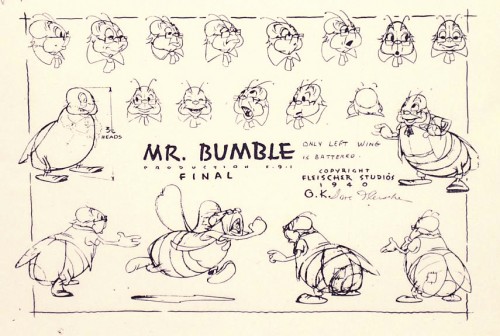 3b
3b
(I found this model of Mr. Bumble on line and thought it worth including.)
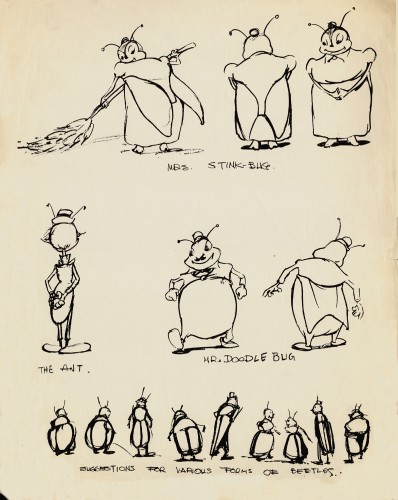 7
7
Miscellaneous Characters – 1
Animation Artifacts &Fleischer &Models 06 Jun 2012 06:06 am
Miscellaneous Models from Fleischer
- Continuing with artifacts from the late Vince Cafarelli‘s collection, here are a bunch of model sheets from a number of different Fleischer Studio productions. I’ve mixed some from the Raggedy Ann shorts, the Stone Age films, the Superman films and one ersatz model from a solo cartoon.
We begin with The Stone Age films. Long before the Fllintstones, there were these inventive shorts about the very same subject, a caveman family living
as though it were the modern day world though they’re still in caveman attire. (Not too different from the Jack Benny caveman in Chuck Jones’ Daffy Duck and the Dinosaur.)
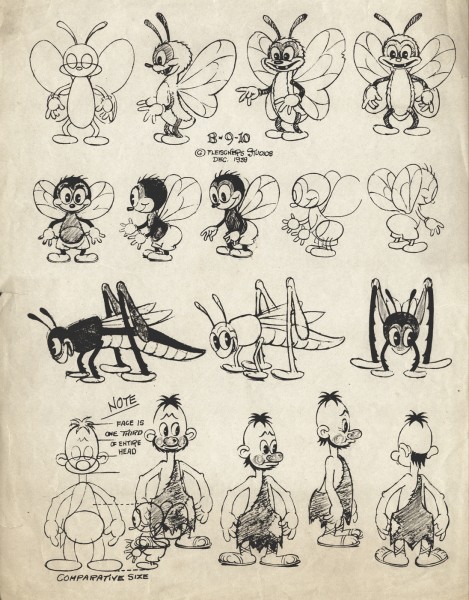 1
1
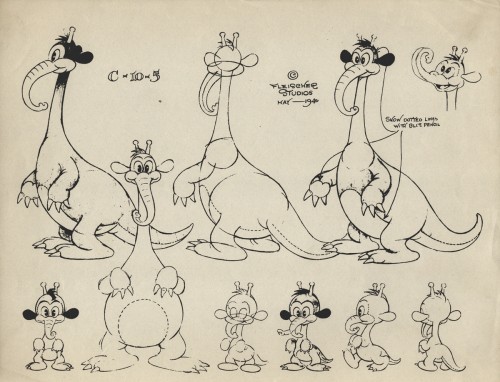 4
4
(Actually, with this model I’m guessing it’s from a Stone Age cartoon.
For all I know, the Fleischers may have tried their hand at Dr. Suess.
There are a couple of models from the Raggedy Ann films. Quite different from the Dick Williams version.
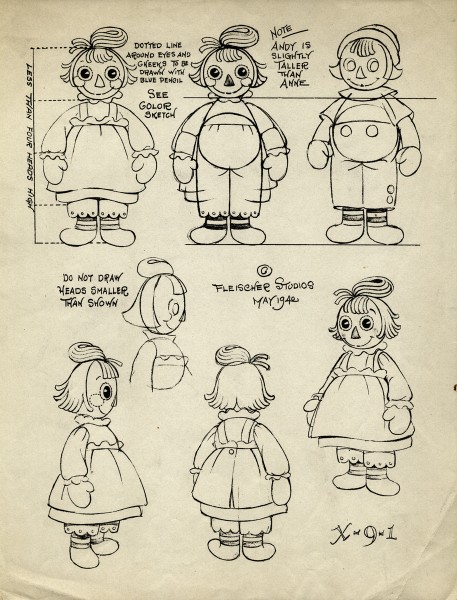 1
1
The Superman cartoons are key to the world of the Fleischer studio and their ultimate attempt at a high quality.
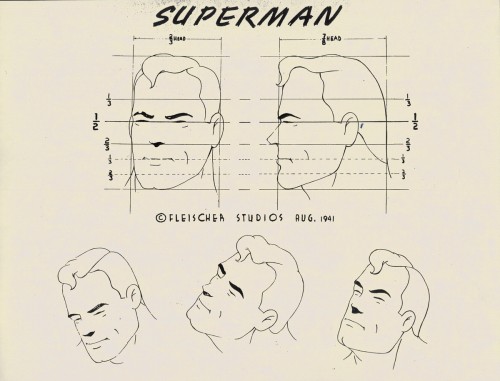 1
1
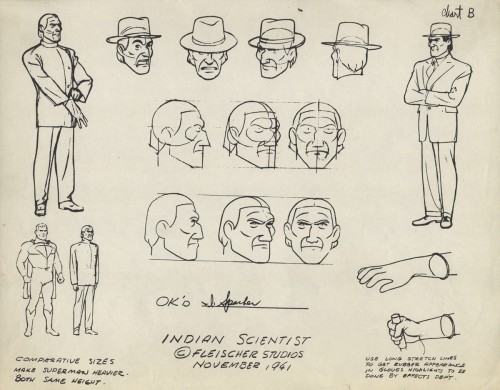 2
2
But of course, it wouldn’t be Fleischer without a hint of racism . . .
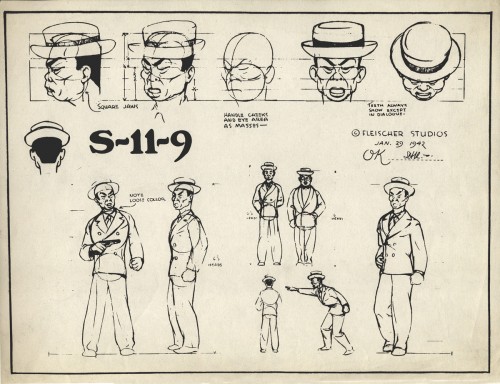
. . . or more than a hint. They should have tried Dick Tracy.
Finally, for today, there’s this left over baby. It isn’t labelled, but it looks to be the baby from the “Gabby” cartoon, All’s Well. If anyone out there knows otherwise, please don’t hesitate to leave a note in the comments section. This model sheet is dated 1942, and the cartoon has a 1941 copyright date on it.
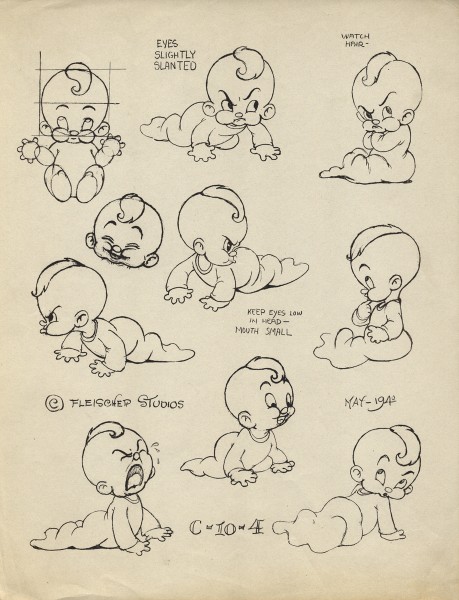
There’s an excellent article in AWN about Charles Thorson who designed the characters for the Raggedy Ann cartoon as well as the Stone Age films. He most probably did the model charts. He’d worked at every known studio in the late thirties, early forties and had settled in to Fleischer’s Florida location whn=enthe brothers were let go, and Paramount took over. It was at this point that Thorson decided to move on to comic book illustration.
The article is by Gene Walz who also wrote a biography of Thorson which was publlished as: Cartoon Charlie: The Life and Art of Animation Pioneer Charles Thorson.
Animation Artifacts &Frame Grabs &Hubley &UPA 28 May 2012 06:21 am
The Four Poster
- One of the real neglects in animation history is the availability of The Four Poster in VHS, DVD or any other format. For some reason, this title has eluded marketers who’d want to cash in on the name of Rex Harrison or his wife, Lilli Palmer. Where’s TCM when you need them.
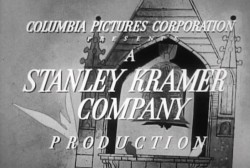 This film was a Stanley Kramer production directed by Irving Reis in 1952 of a play by Jan de Hartog. It tells the life story of a marriage between the husband and his wife. In fact, the film is so insular that it never leaves the bedroom, and it revolves around the “four poster” bed in that room. For the film, they chose to open it up by leaving the bedroom via animated inserts done by John Hubley at UPA. There are some 20 minutes of the film done by Hubley/UPA, and it’s extraordinarily progressive animation for the time.
This film was a Stanley Kramer production directed by Irving Reis in 1952 of a play by Jan de Hartog. It tells the life story of a marriage between the husband and his wife. In fact, the film is so insular that it never leaves the bedroom, and it revolves around the “four poster” bed in that room. For the film, they chose to open it up by leaving the bedroom via animated inserts done by John Hubley at UPA. There are some 20 minutes of the film done by Hubley/UPA, and it’s extraordinarily progressive animation for the time.
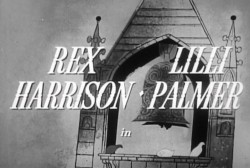 I own a good 16mm copy of the whole film, and cut the animation segments separate from the feature, I allowed a friend to make a video copy but was very disappointed with the results – out of focus and almost unwatchable. In the past couple of weeks, another friend led me to a second DVD copy which is also out of focus but not as bad as the first.
I own a good 16mm copy of the whole film, and cut the animation segments separate from the feature, I allowed a friend to make a video copy but was very disappointed with the results – out of focus and almost unwatchable. In the past couple of weeks, another friend led me to a second DVD copy which is also out of focus but not as bad as the first.
I’ve wanted to focus on this film for some time, hence I decided not to wait any longer and am sharing frame grabs with you of this muddy, soft focus version. You can still get the idea. If another, better copy turns up in the future, I’ll rework these images and repost it.
Here are bits from the opening credits. Lots of traveling right and then left and then right again.
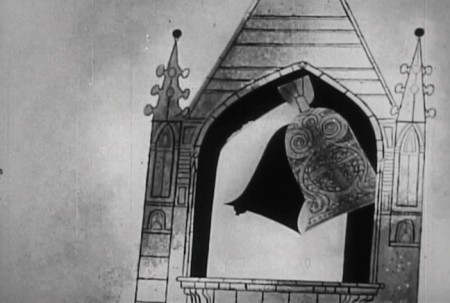 3
3The film does get very claustrophobic staying in the one bedroom set
for the entire film, with just the two characters, husband & wife, to talk
us through most of the movie. It’s exhausting.
This makes the animation more welcome than it would ordinarily be.
You’re dying for any excuse to change scenery and move the story forward.
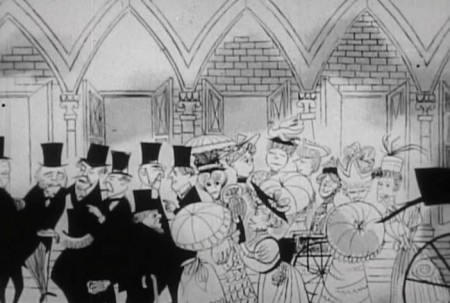 4
4
On top of this, the live action is very theatrical
whereas the animation is full of life and quite lyrical.
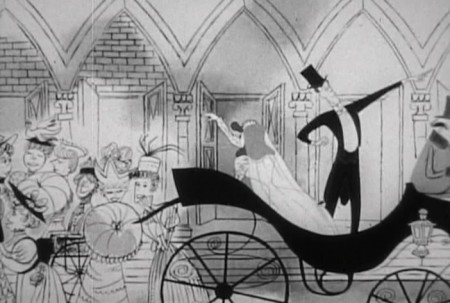 5
5
The animation does reveal a good part of the story from the
birth of their boy to his death in WWI on the front lines.
(Hubley designs one of his greatest sequences for this one.)
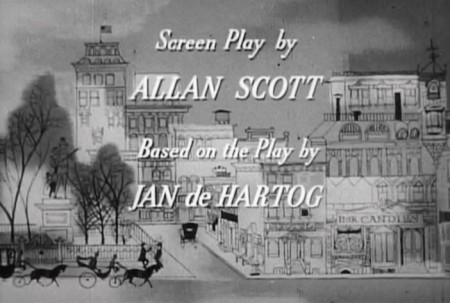 8
8
Supposedly, the film was sent to Yugoslavia for a run.
Some of the people in Zagreb were able to kidnap the film
and hold onto it for a number of additional weeks. They
studied it closely and copied it.
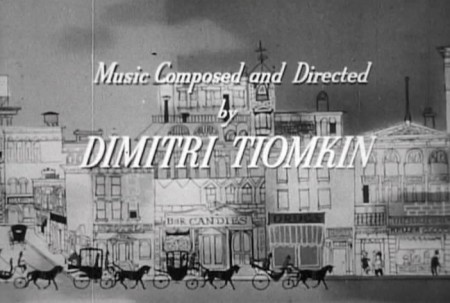 9
9
When they were finished the print was returned to
the States, and they started up Zagreb animation with their
new-found knowledge and inspiration. A bit more than inspired,
shall we say. How very 21st Century of them
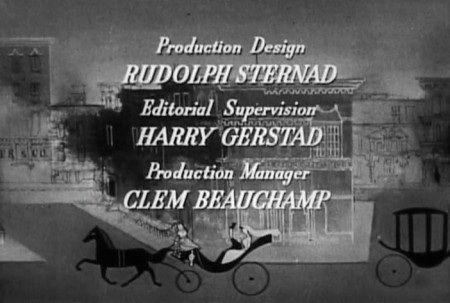 12
12
In his book, When Magoo Flew, Adam Abraham doesn’t give a lot of
space to the work on this feature. However, every small comment
seems valuable since so little has been written about this film.
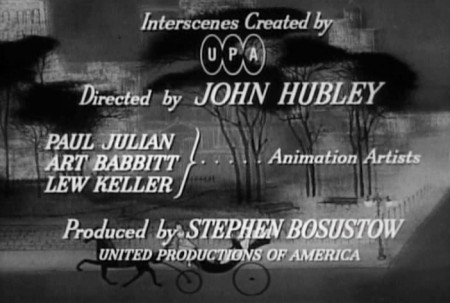 13
13
Abraham says that Hubley and crew went onto this directly after
finishing Rooty Toot Toot. They were broken into small groups
with each group doing one of the interecenes in the feature.
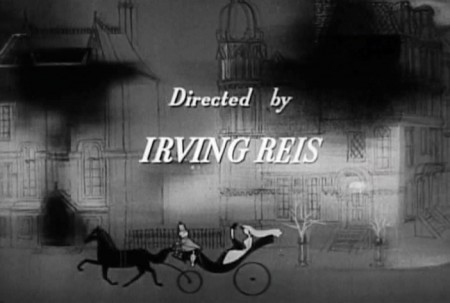 15
15
Paul Julian oversaw the stylistic representation of the War
and Art Babbitt animated the sequence showing the effect
of the war on the soldiers coming home.
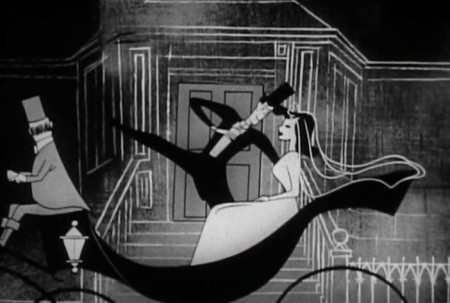 16
16
In total, it’s an enormous accomplishment.
____________________
.
The first animated intersection shows the Rex Harrison character going off to work as a teacher in a boys’ school.
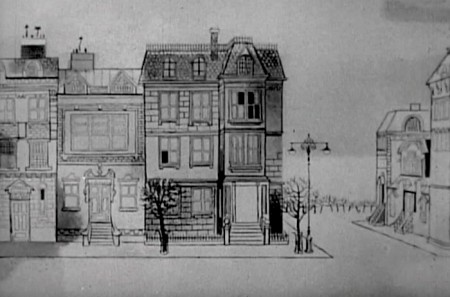 1
1
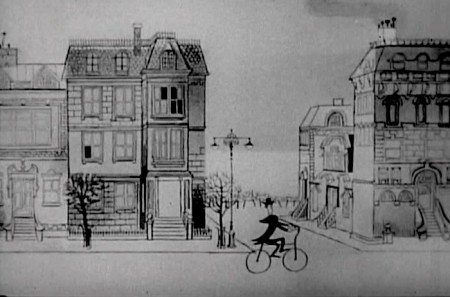 2
2
Out of the home, Rex Harrison’s character
comes cycling on his way . . .

. . . to school. Like many other sequences in this animation,
he rides a long pan to the school where he enters on bike.

Inside the school, we echo the first scene with another pan.
This time we pan from class to class ending with . . .
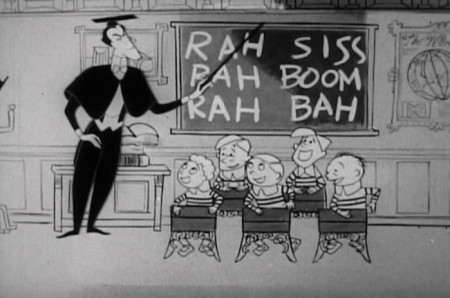 5
5
. . . Rex Harrison’s very unethical class, where the kids are having fun.
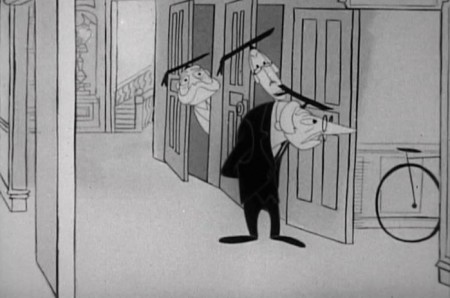 8
8
The raucus noise of his class is disturbing other teachers.
They don’t like the students having fun.
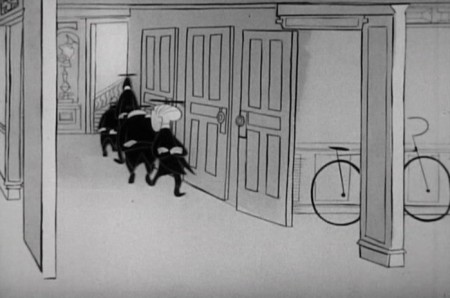 11
11
Off to the Dean’s office to complain.
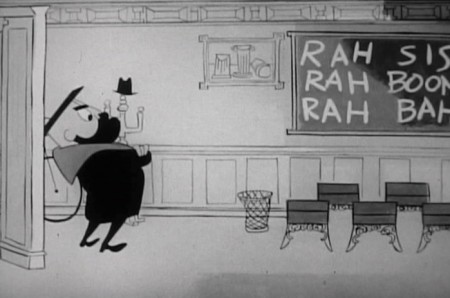 16
16
The Dean breaks in to something too much fun.
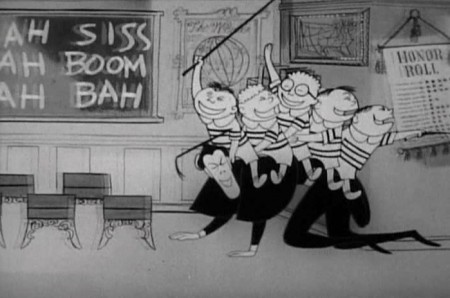 17
17
Even with the soft focus, you can see
that the character design is great.
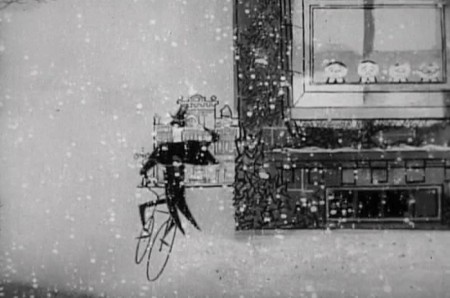 20
20
He goes off into the sunset of a
snow fall.
Back to live action
Animation Artifacts &Fleischer &Story & Storyboards 23 May 2012 05:32 am
Popeye Storyboard – part 3
- We’ve come to the third and final part of the storyboard for the 1949 Paramount Popeye cartoon, “Barking Dogs Don’t Fite.” These storyboard drawings come from the late Vincent Cafarelli‘s collection of artwork he’d saved from the divers studios in which he worked.
The storyboard was done by Jack Mercer and Carl Meyer. Their drawing styles are both expressive and markedly different. I suspect that one drew the human characters and the other the animals. The drawings of Bluto are just out of this world, ripped right out of the early 20th century comic book pages. I also suspect these were done by Jack Mercer, but I have nothing but a hunch to give me that guess. I believe he was working at the studio longer and might have had more of the early Fleischer grit in his drawings as opposed to the cartoon slickness that would’ve come from later employees’ work. Each drawing is done on inexpensive 8½ x 11 paper. As usual with these continuing posts, we pick up with the last drawing from last week’s entry.
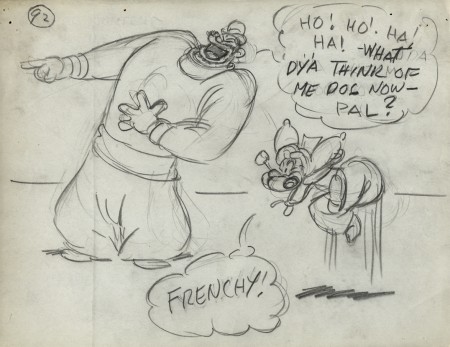 92
92
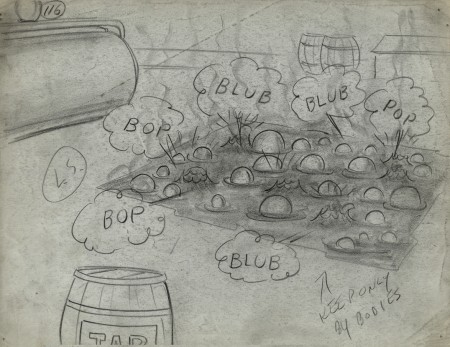 116
116
Note that drawing #117 is missing.
.
___________________________
Here’s the full short as seen on YouTube.
I wish the look was a bit closer to the board, however
some of the layouts in the final film are significant
improvements over the planning in the storyboard.
.
Animation &Animation Artifacts &Frame Grabs &UPA 22 May 2012 06:55 am
Nelly Bly’s Twisted Arms
This is one of my favorite scenes of all time. Nelly Bly is on the witness stand, and she’s constantly straightening herself out as she gets deeper and deeper into her side of the story. Grim Natwick’s animation is perfect, and John Hubley’s direction and design is even better. The judge, behind her, couldn’t be better positioned.
This is a great cartoon, possibly UPA’s best. It lost the Oscar to The Two Mousketeers, a Tom and Jerry cartoon, and not even a particularly good Tom and Jerry cartoon. It would take another ten years before AMPAS ruled that you had to see the short films to be able to vote on them.
I tried to include this scene with its soundtrack, but it took longer than I could afford to give it.
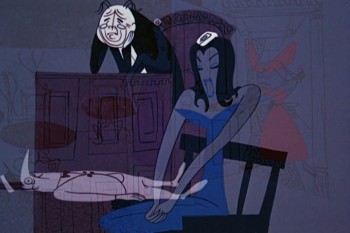 01
01
______________________
The bump in the middle is a hold wherein there’s a
camera move. I replaced it with a short dissolve.
Animation Artifacts &Models &Story & Storyboards 16 May 2012 05:53 am
Popeye Storyboard – part 2
- I continue posting this storyboard from the 1949 Popeye cartoon, “Barking Dogs Don’t Fite.” This is part of the late Vince Cafarelli‘s collection of animation artwork. He’d saved it from the different studios he worked at.
The storyboard was by Jack Mercer and Carl Meyer, and I’m not sure as to who drew what. There are definitely two different styles in there especially in the way Popeye and Olive are drawn. Bluto also has an original look here, but he seems to stay constant.
Each drawing is done on inexpensive 8½ x 11 paper. One wonders if they even made an animatic of the film. None of the board has any registration.
We pick up with the last drawing from last week’s post.
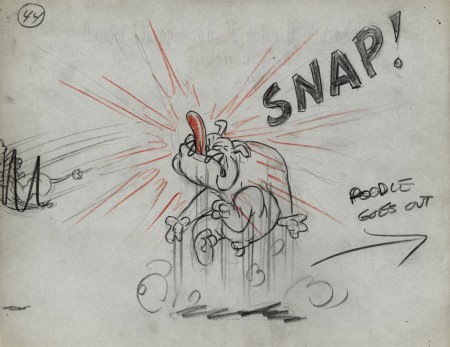 44
44
.
___________________________
Here’s the full short as seen on YouTube.
I still can’t get used to Popeye’s powder blue uniform.
I wish the look was a bit closer to the board, however some of
the layouts are improvements over the planning in the storyboard.
.
